Hello everyone and welcome! This is a really cool blog post I’ve been building up to for quite some time now, and I’m excited to finally show it off. To start with, longer-term readers will remember that about a year or so ago I showed off the initial steps in procedurally generated riddles – one of the key novel features at the core of this game – and indeed I gave a talk at the Roguelike Celebration on this exact topic. Those who were reading back then might recall a screenshot like the one below, in which I showed off some examples of what procedurally generated riddle clues might look like. The purpose of some of these – such as the maps or the sentence – are pretty obvious, while others were intended and designed to be rather more cryptic, and needing some more attention and thought to decipher their meaning. As this is really quite unexplored game dev terrain, I confess I thought I did a really good job back then with what I had to show off a year or so ago. We had a number of different types of clue, which could then yield – once the generators behind the clues are completely finished – a tremendous number of different clues.
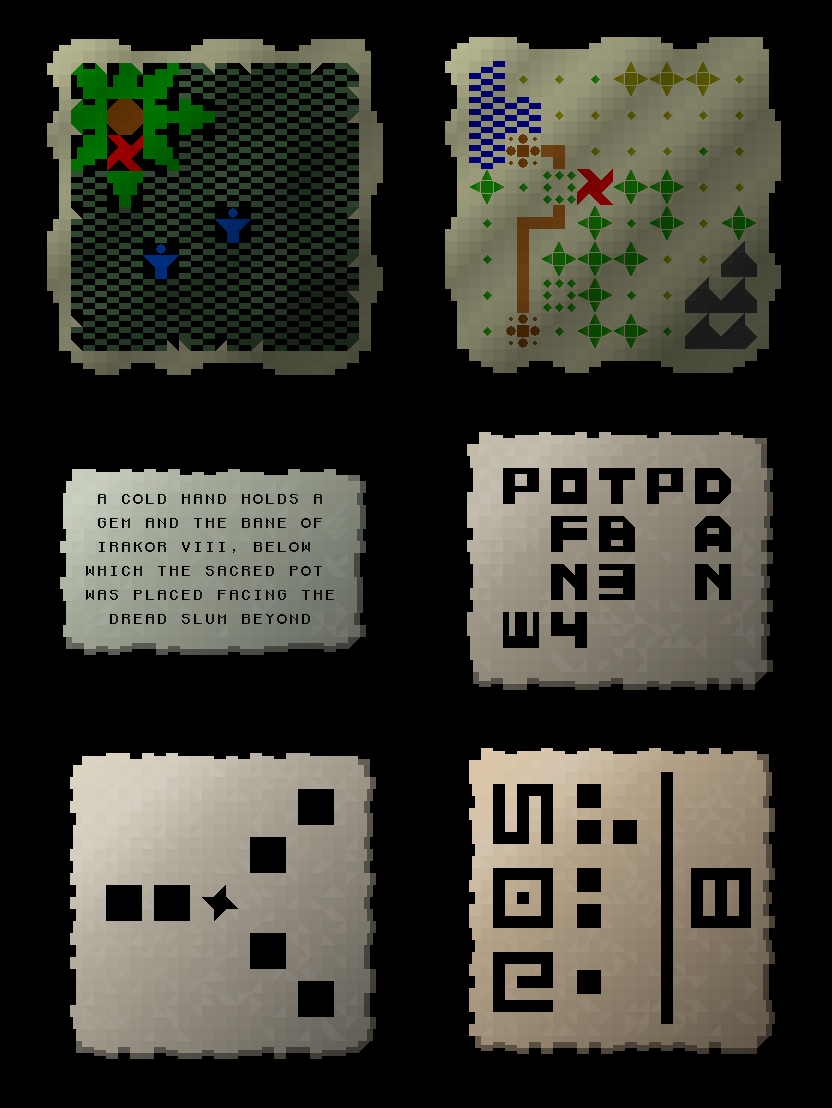
However, as it turns out… we were only getting started. Strap in, friends – it’s about to get interesting. I’ve been doing a huge amount of work on this in the past six months, and in this post I’m going to show off all the archetypes for clue generation currently in the game (there are a lot now). Since much of the other game information is textual, i.e. from books and from conversations with NPCs, I’ve tended to go more visual with these, though you’ll see there’s a good mix of the two below. The possibilities of these into quest generation are wild, and so without further ado, let’s get started:
Maps
Let’s start off with perhaps the most obvious type of clue through which you might get to something secret – a map!
These were amongst the riddle and clue types that I described in the previous post, but I’m putting them here again because the whole generation system has been redone in order to allow for far more variety in what sorts of locations are shown – which is to say, now basically any location – as well as the addition of new symbols on both the world map and local map options for new sorts of structures and new items, furniture, locations, and things of this sort. Really important here has also been unifying the generators for the other sorts of notes with the maps, since up until now the maps were separately generated in a far slower way than the actual notes were. Indeed, every type of note – and there’s a lot of to get through this blog post – all now spin off from a single generator that handles things like drawing the note’s background, correct colours, its width and height, what it’s called when the player looks at the note, and so on. This is just way more efficient and has allowed me to develop a modular system by which I will be able to add any number of new clue archetypes in the future without having to recode basically anything, and being instead only coding whatever comes new in that new model. I describe this more right towards the bottom of this entry, but for now, here are some examples of what the map clues might look like for the global map…
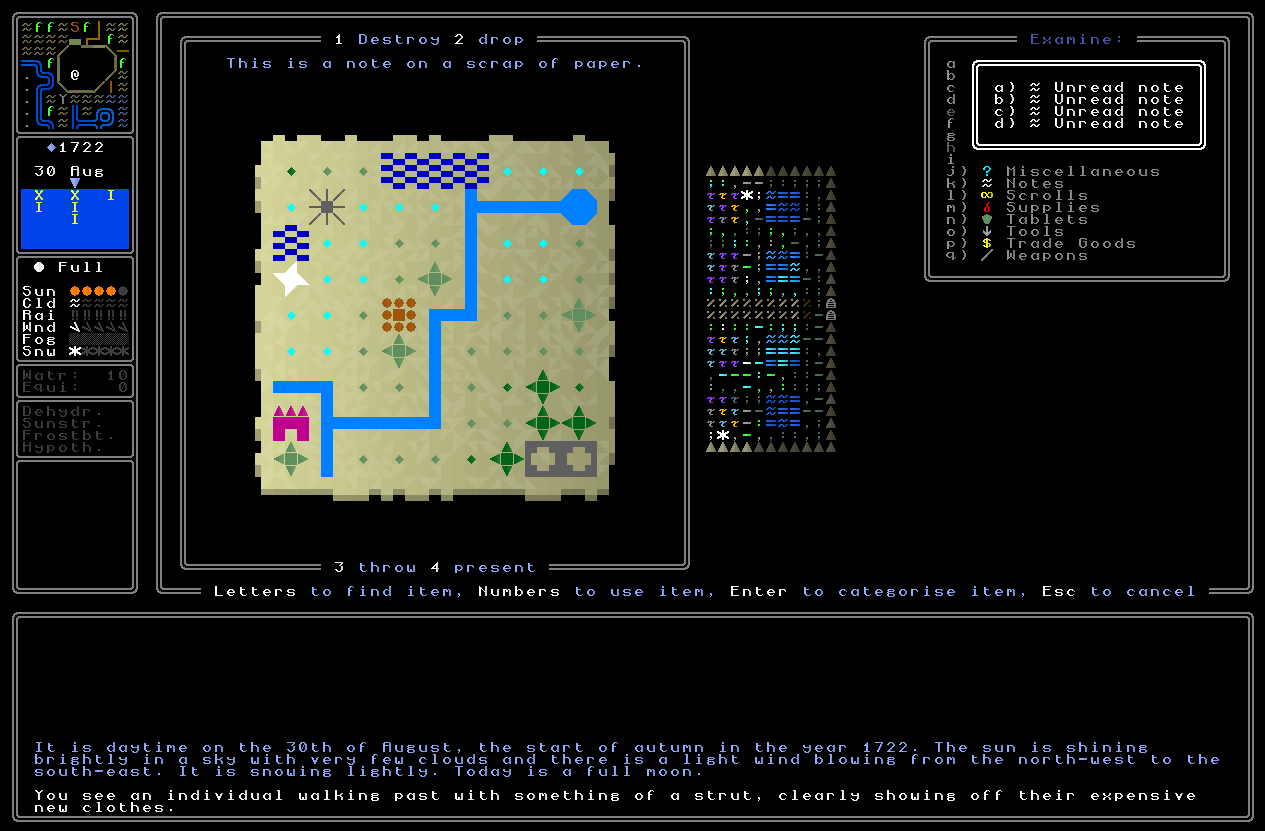
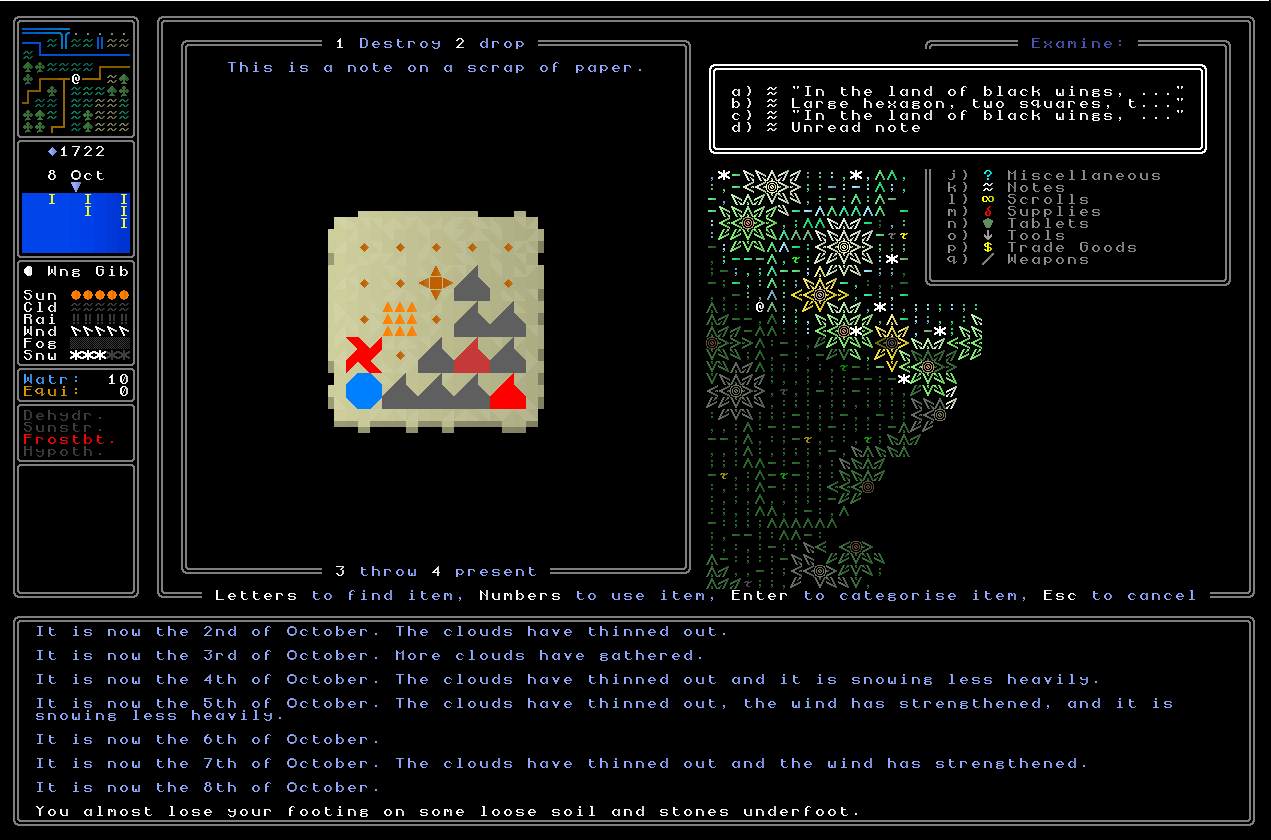
…where in these examples we see a polar region with a river, a lake, some forests, various sorts of settlements and the like, and then a desert with a lake and a mountain range and two volcanoes (one active, one dormant). Then, the local / human-scale map (i.e. the one the player physically walks around on):
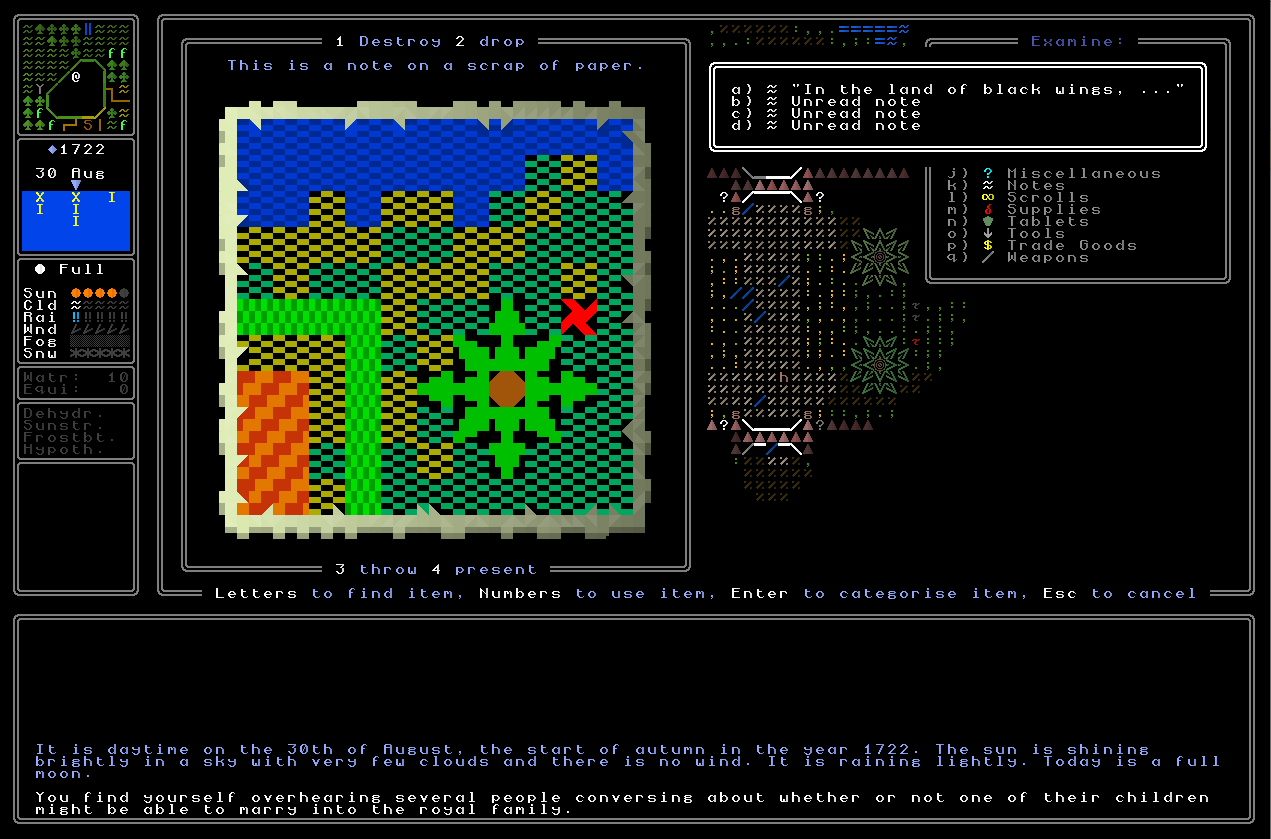
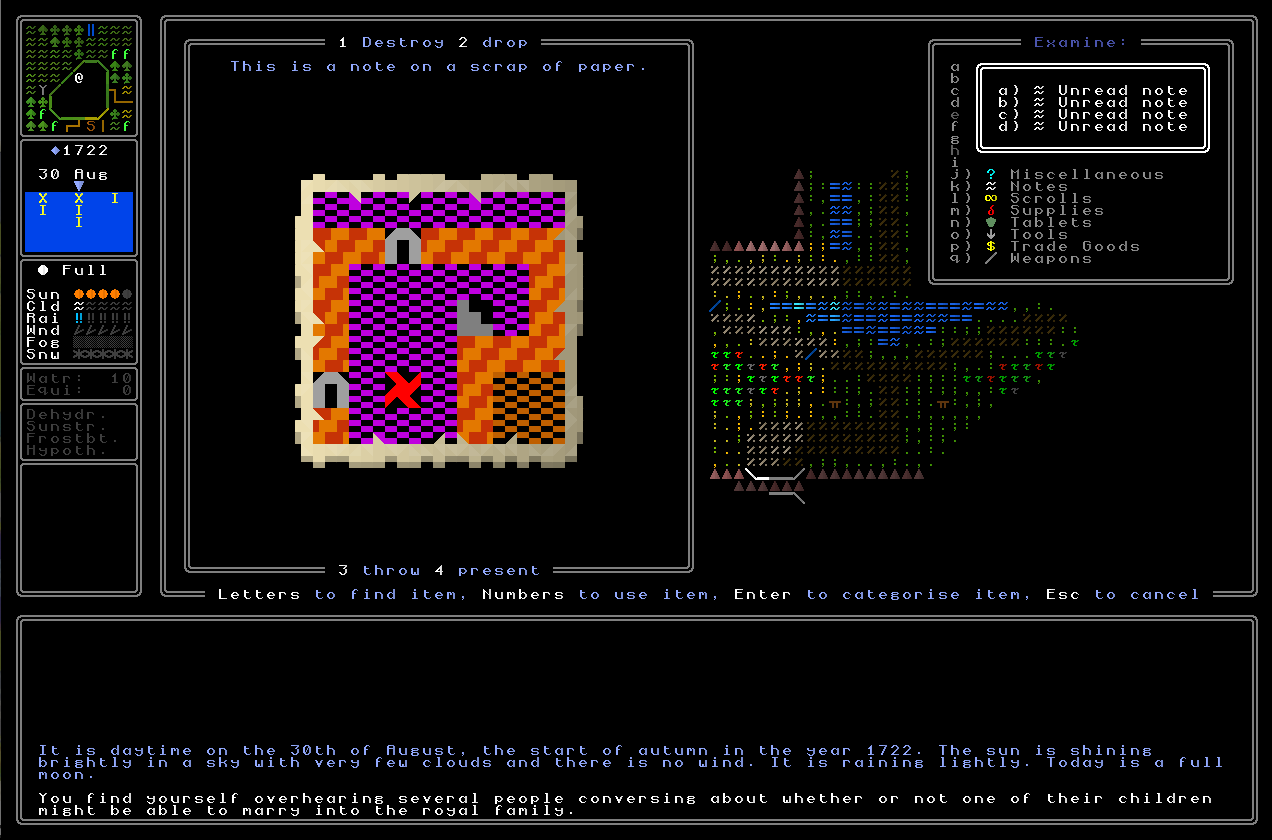
Here, then, in the first one we’re looking at a temperate area with a tree, a coastline, a hedgerow and a building, and in the second one we’re looking at the inside of a building with swanky flooring, some doors between rooms, and a staircase. As I mentioned before in that other entry, I thought it was important to ensure that the artistic styles for these two sorts of map are very distinct so that the player never has any doubt about which is currently being looked at. I suppose it is the tiniest of tiny hints, as it were, but it’s so minor that I think it’s actually appropriate here to remove confusion and ensure that the consistency across what the player is looking at. As with all the potential clue types I’ll show here, my intention in the 0.11 release – currently being developed, and which will include the first ever procedurally generated cryptic riddles – will see the player starting off with a number of initial clues drawn from all these different archetypes, while future versions should be able to generate many many riddle and quest threads that take one all throughout the world cultures, religions, and lands. I like the idea of interweaving various kinds together, so a quest thread might have some clear and explicit objectives, some exploring, some diplomacy, some riddles, some combat (!), and so on.
But that’s in the future, so for now, for starters – here are the maps.
(As an aside, here’s a sort of debug map, showing almost all the characters for the “local” map variation. I wonder what they all mean! I’ve also vaguely toyed with the idea of having a database of potential symbols for each in-game thing, and then those are randomly chosen at world gen… but we’ll see about that…!)
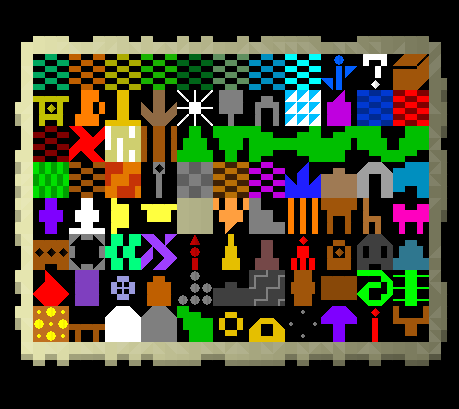
Sentences
Let’s come next to the sentence clue / riddle archetype. These were also shown off in the previous set and there’s not actually a great deal more to add here, except to say that I’m working hard on the generator for producing these sentences, and that once the lines are written the game then chooses an appropriate note width and height to house these sentences. Originally and in the previous iteration I had these all shown in capital letters because I thought that would aid in readability by making the letters larger, but after continued experimentation it has become clear that just normal writing here is more readable than all uppercase letters. That change has therefore been made, along with integrating this into, as I mentioned above, the same basic generator as everything is now using, such as maps and all the other types of clue I’ll be showing off later in this post. Given just how exciting the prospect of procedurally generating verbal riddles is, I anticipate a large portion of the game’s clues being maps or sentence’s, and I would certainly expect the player to see these in the 0.11 release, as well as being a substantial type that they see other than in later releases once there are many threads in place. All the generators producing these clues are in varying states of completion, and one of the main tasks for the coming months will be to develop all of these generators to a high standard. Here for now, though, are two good examples of what these might look like in-game:
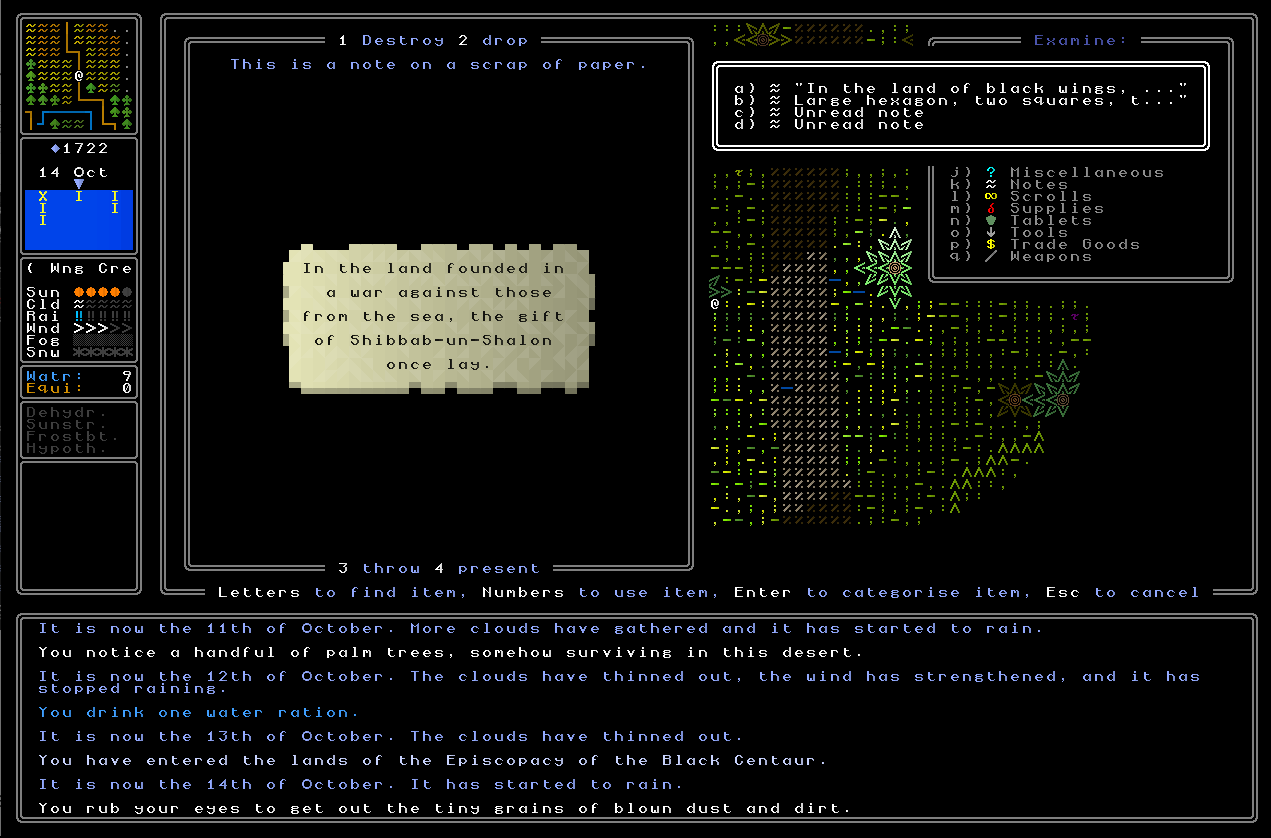
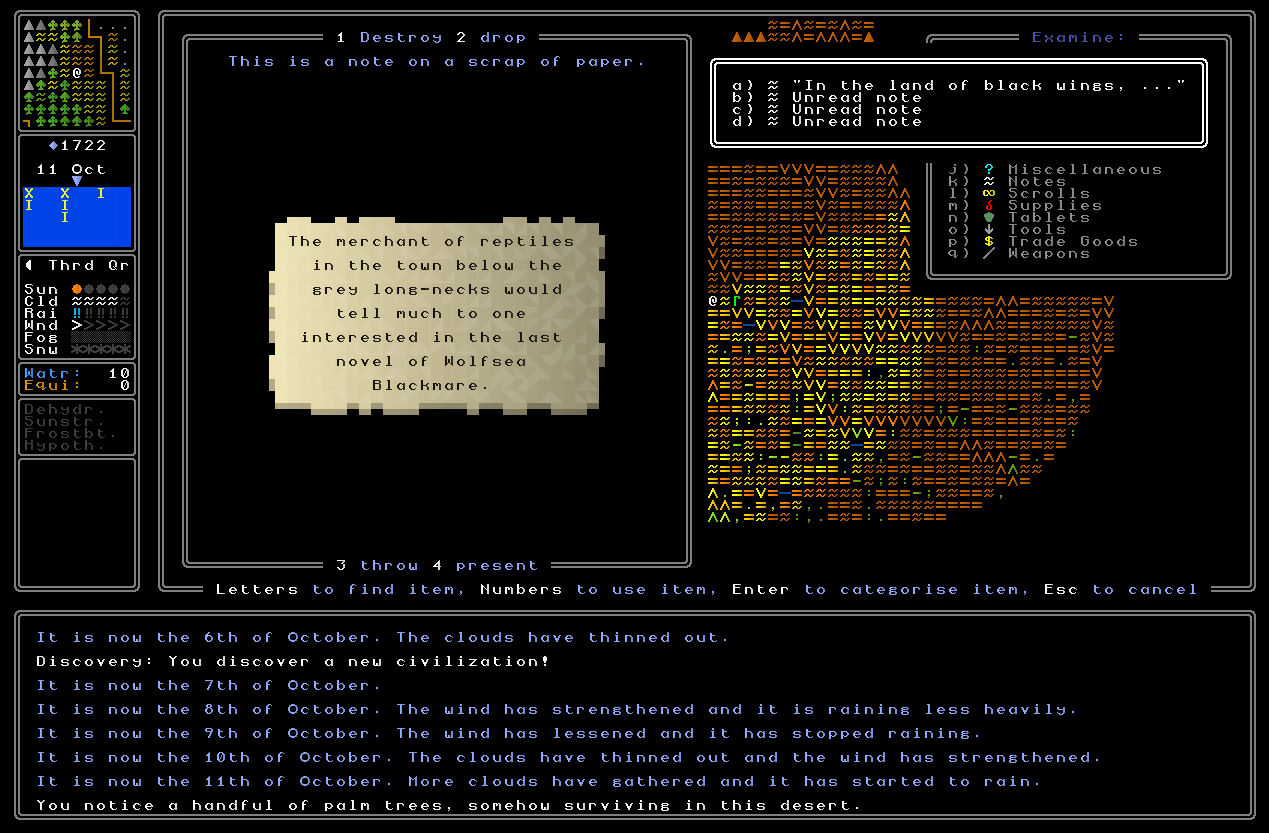
Pictures
We come now to the picture archetype, which is the first one you can’t see in the previous set of archetypes I developed in the picture at the top. These are honestly absurdly huge in their possibility space, and there’s a lot to say here, so let’s get into it. I set myself the task here of being able to create a generator which cannot just procedurally generate a logical image (itself a pretty big deal, given the embarrassing slop which Gen AI products turn out), but ensure that that image has actual meaning within the game world, and this thus gives the player information about something they could do or should do, or just background data which will then connect with some other clue or some other riddle in a useful manner. The first step of this was creating a massive database of symbols to represent – from a side view, not a top-down view – basically everything you can find in the game, and this is indeed is what I’ve now done. I’m actually not sure how many there are now, but I think it’s something like six or seven hundred symbols (not counting the statues, see below) which I’m then programming the game to stitch together in logical ways to create a coherent image of something actually found (itself also generated, of course) within the game world. Many of these component pieces show parts buildings, or animals, or items, or more abstract or obscure things like stars or planets, times of the day, items, clothing, certain sorts of terrain or land, and things of this sort. Whereas the map archetype of course shows you information from the top down, whether it’s the world map or the local map, the idea here was to create a system which can show you a place either from the side on, or in a form of symbolic or abstract representation which will give you a hint as to that place. It’s in this regard that the two kinds of different picture that can be generated here arise.
So, the first of these I think of as the abstract picture – it’s a selection of symbols put together and separated by a one-character space which would give you some information. These are not meant to be read literally, but rather in a more figurative or abstract way. Here are some examples to give a sense of what I mean:
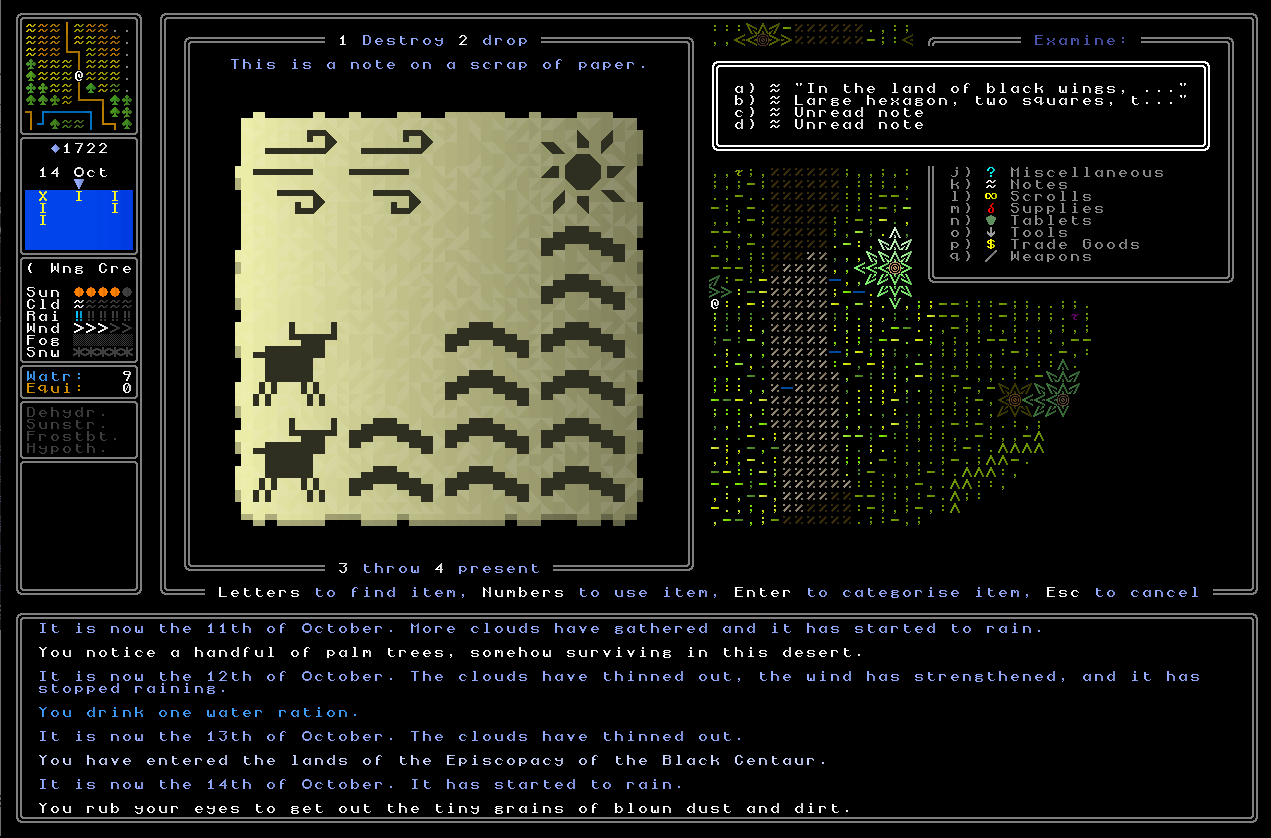
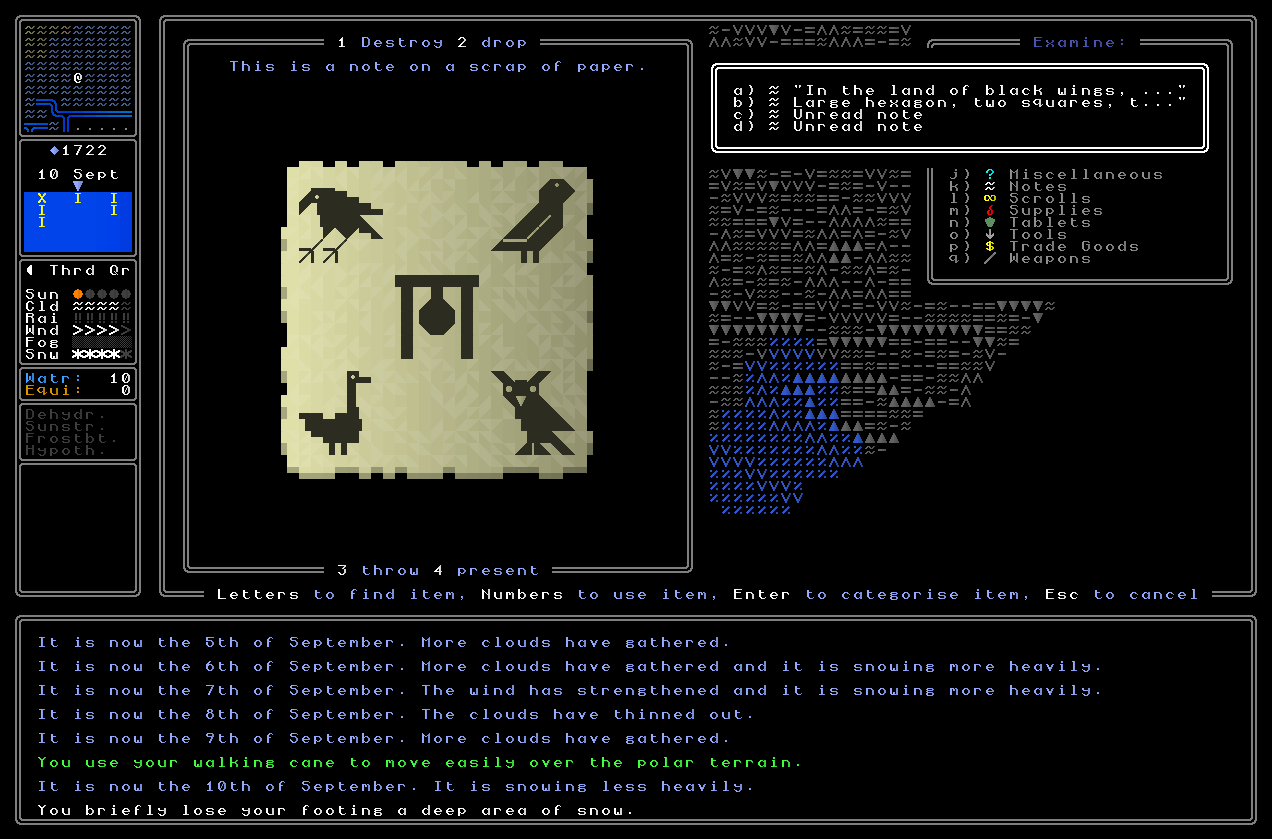
So, in the first example the player is not being referred to place where there’s an exact amount of water, and exact number of bison, would instead you might want to look for shoreline which looks like that, or an area which is known for bison, and then go at that particular time of day – when there’s a 2/5 strength wind blowing to the east, and only a little bit of sun. It is therefore showing a specific location, but it is not showing what that location actually looks like, but rather some of the key traits – it’s next to the coast, it has bison, and you should approach it at a certain weather condition. In the second example, we see a gong – which is one of the rare extra religious things that can spawn for a particular religion – and four different sorts of birds surrounding it (clockwise from NW, these are birds of prey, finches, owls, and geese). As with some of the other archetypes here this could also again have many different interpretations, but it would be the objective of the player to combine this with other existing information sources of knowledge they have, and to look at what they can find out about the game world, in order to deduce which possible interpretation is the one to follow. Perhaps there’s a religious building belonging to the religion which has gongs which is in the middle for areas known for those particular birds – in which case you should go there. Alternatively, perhaps a priest of that religion will tell you something of interest if you talk to them about those categories of bird. Or, perhaps it means that you should find one of these gongs and place near it in the pattern as shown of items which relate to each of these creatures, such as perhaps a specific book or treatise discussing that particular creature, and then something might happen.
In more abstract design terms, one of the tricky things here of course will be discouraging guesswork and brute forcing and encouraging thoughtful solutions, but this is a very complex and abstract topic I’ll be doing a blog entry on later. With the partial exception of something like Noita, permadeath games and cryptic riddle games haven’t really been combined before, because nobody has been generating cryptic riddles! This unexplored terrain is obviously super exciting, but will need a lot of thought when you’re not in a game you can reload to try a new solution in. But for now though, I think it’s clear how these sorts of abstract pictures work, and when coupled with this massive database of symbols I’ve drawn up – which I’m in fact not going to put up here, party to preserve some secrets, and partly because at this point it essentially resembles a tile set and I don’t know whether I’d feel comfortable with another project using all the symbols – but it’s one of the real achievements of this last couple of months of work. There are some really nice graphics in there, and that indeed brings us to the second sort of picture.
This is what I’ve taken to calling the specific picture rather than the abstract picture. The abstract picture as previously described brings together a number of visual elements to tell the player about something, somewhere, somewhere, but in an abstract rather than precise sense. The specific picture, however, is designed to show an exact place, or event, in some detail. This again I imagine as having two categories. One of these would be a side-on view of something that the player can go and interact with in some way, and the key puzzle here would involve using the clues and information in the picture (and maybe other sources) to match it to the top-down image you normally see in the game (and potentially the close-up examination pictures) and therefore know where you’re being sent towards. The other type would be a depiction of a historical event or indeed a religious event, so you might find pictures showing moments from religious texts or legend which didn’t in fact happen, but how they are depicted or shown throughout history then becomes important. Whereas the abstract pictures have a one-character gap between the symbols in order to give a slight sense that we’re not looking at a literal picture but rather an orientation and constellation of pictorial elements, these specific pictures have no gaps in order to give this sense that we’re looking at a specific place or a specific moment. Here are two examples:
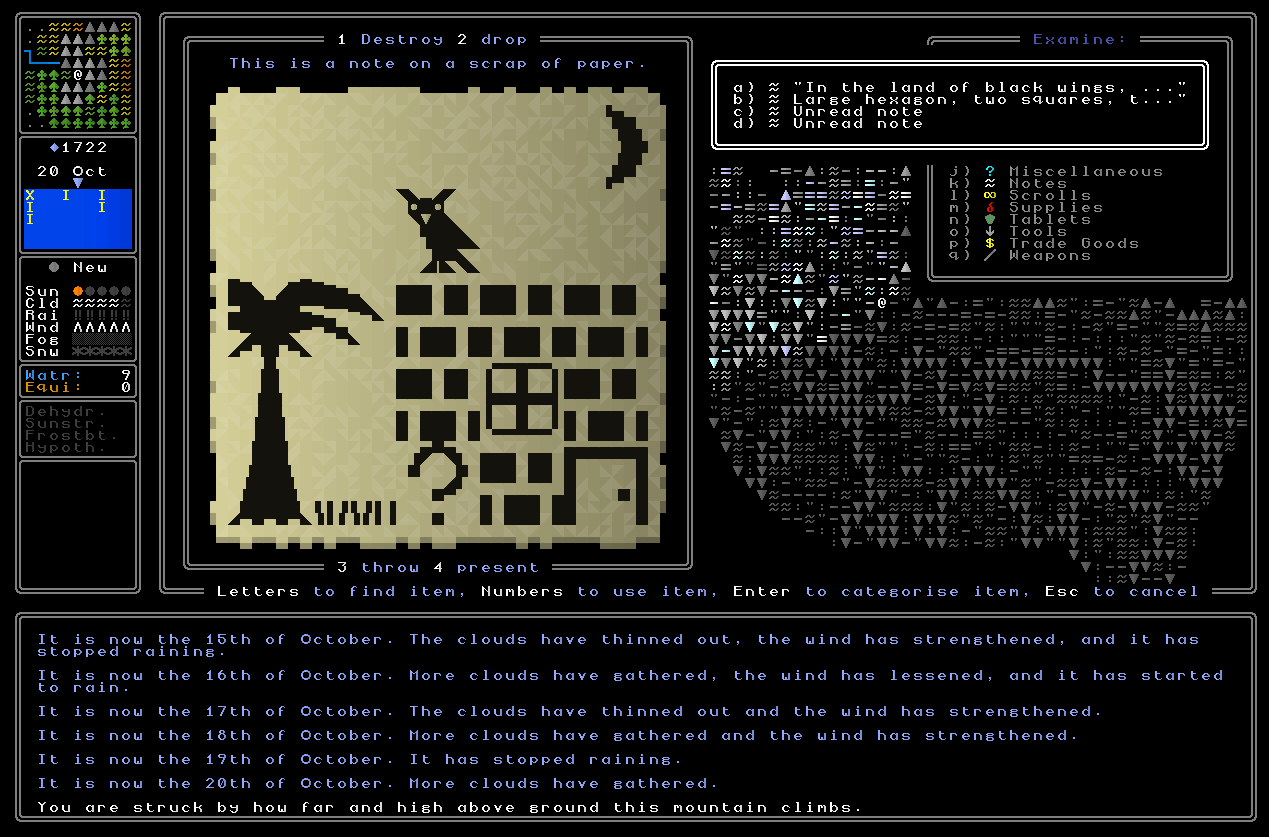
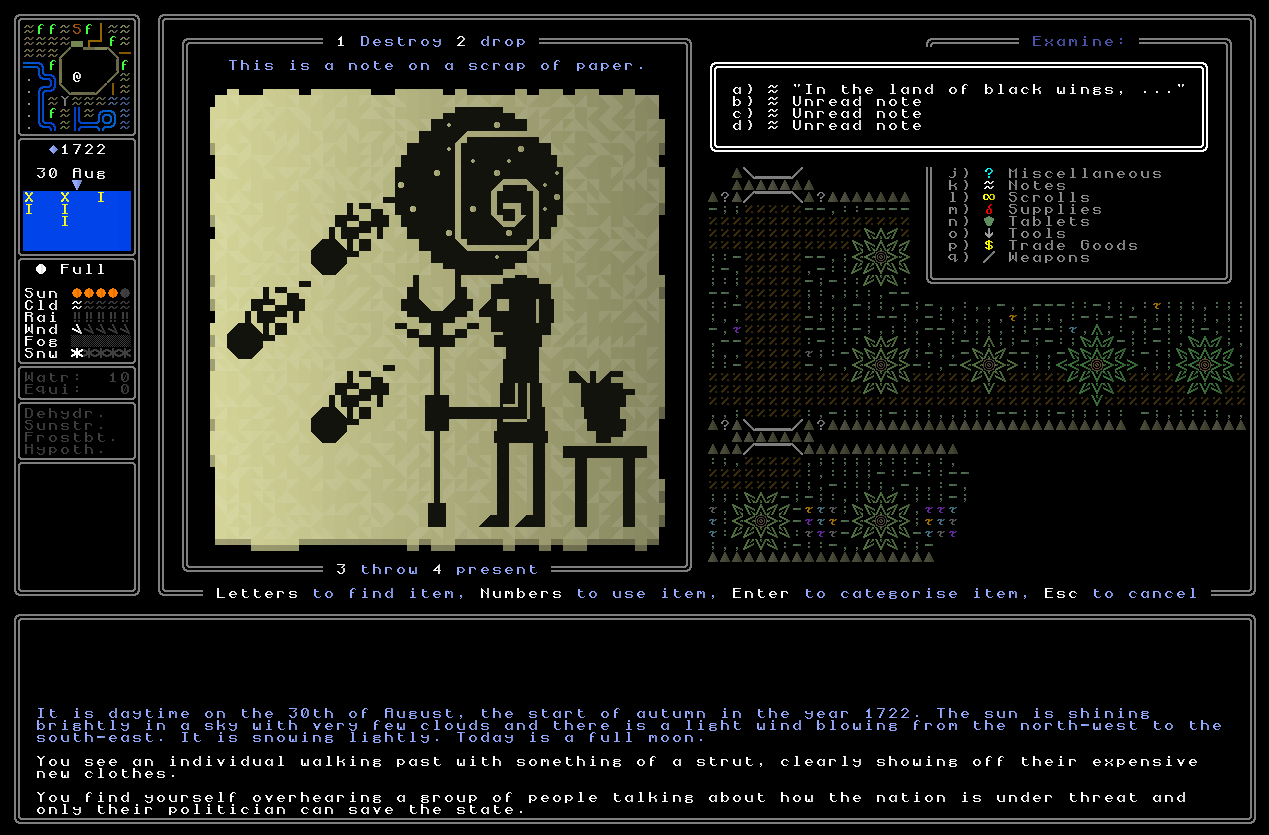
In the first one then, we could see a lot of information here that would help to assist the player in knowing where they should be going and what sort of thing they should be looking for here. Given the presence of the palm tree we could reasonably expect to be looking for the desert, but also somewhere with normal terrain as well as sand, and then we’re looking for a civilization which likes squares – as we see here square windows and square doors, rather than other shapes – and then within this civilization you might want to seek out somewhere where owls land during a waxing crescent moon, and then look at that building and on the right tile, there be something on the wall which you want to see. Given how many buildings there might be in a civilization, this clue – like with many of the clues – will probably be designed to be using the used in tandem with something else, which might specify the type of building, and then with that information you’d be able to hunt down the specific building and get there at the right time. In the other one, we see a shot from some kind of religious myth. We’ve got a large planet with three meteors coming out of it, a person holding a particular staff – as an aside, all potential religious staves also have very clear and indicative micro-versions here in the picture database, which took quite a while – and we also see here a beating heart on top of table (!). These seem like pretty distinct aspects so they’d be referring to a particular myth, or perhaps giving you information about a missing part of that myth, or maybe a ritual. Perhaps the appropriate holy book for instance mentions this planet and the meteors as part of a vision that an ancient priest of this religion had, but it but it doesn’t tell you what item this priest had with them when this was going on, and you need to find out – and the clue fills in that gap by letting you know it was a heart. Again, I’m still working on the generator for these images, and as you might expect this is a wildly complex generator, which will probably merit an entire blog entry (or two!) in the not-too-distant future. However, for now, I hope these give a fantastic idea of the flexibility of this picture generation system for making both abstract, and specific, visual clues.
As a final point, regular readers will remember that the procedural generation of religious statues is one of the main things I’ve been working on in this release, and which look – if I may say so…
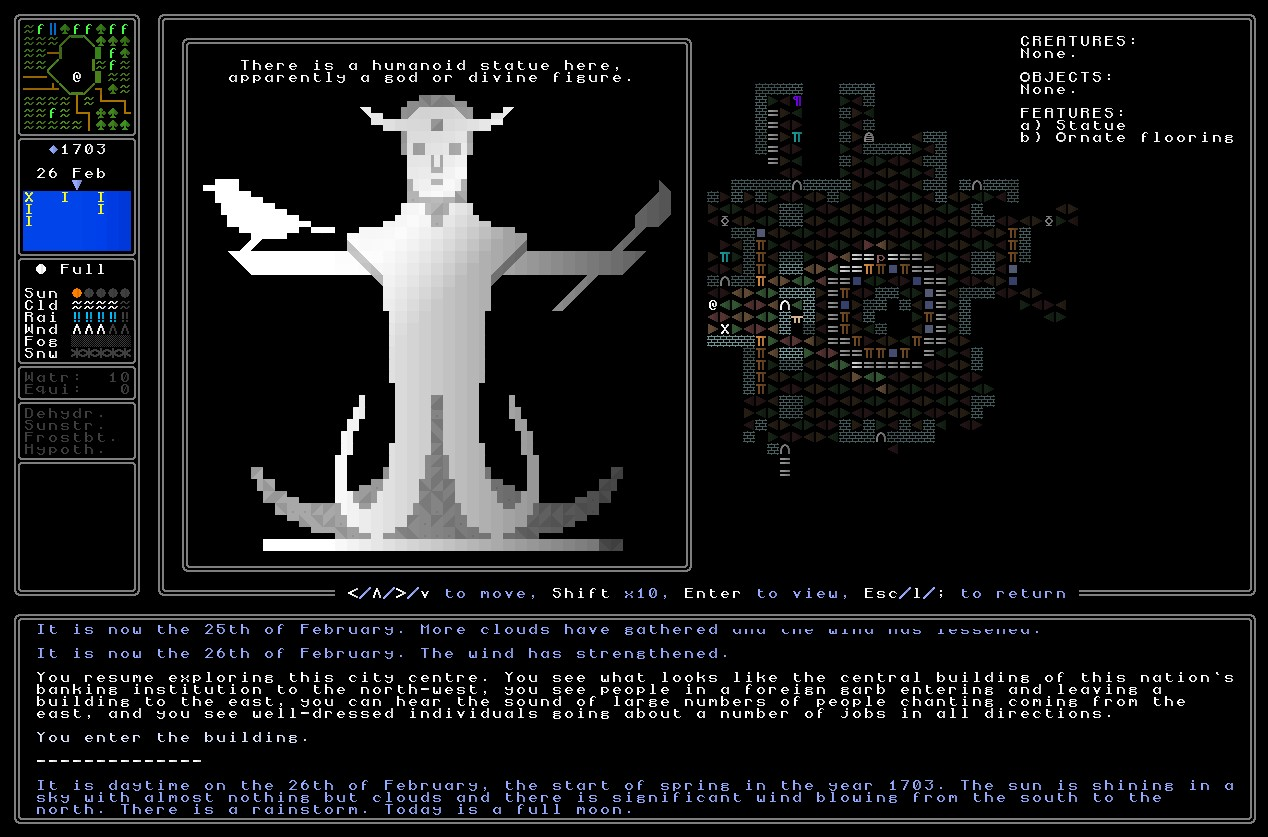
…pretty cool. I needed to find a way to represent these in this smaller clue format, and so a secondary generator has now been put together through which the game can take any statue with any head, torso, arms and base, and create a very small 7-by-7 ANSI representation of that statue which is unique and distinctive and cannot – if a player has the required information – be mistaken for any other statue. I also love how these look, and as with so many other things they will reward the player who is paying attention to the game world and getting to know its civilizations, it religions, and so on. One would never see a clue like the one below in the game, but as just a fun little debug demonstration, here’s a note with 13 examples of the smaller versions of the statues on it:
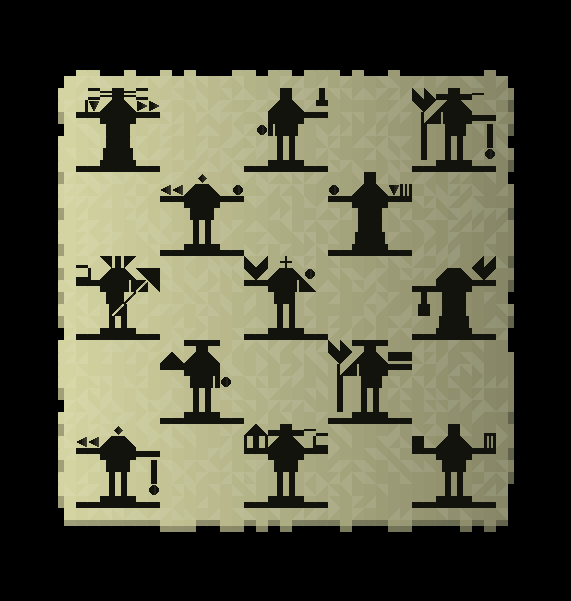
And then, here’s a full-sized religious statue I generated at the same time:
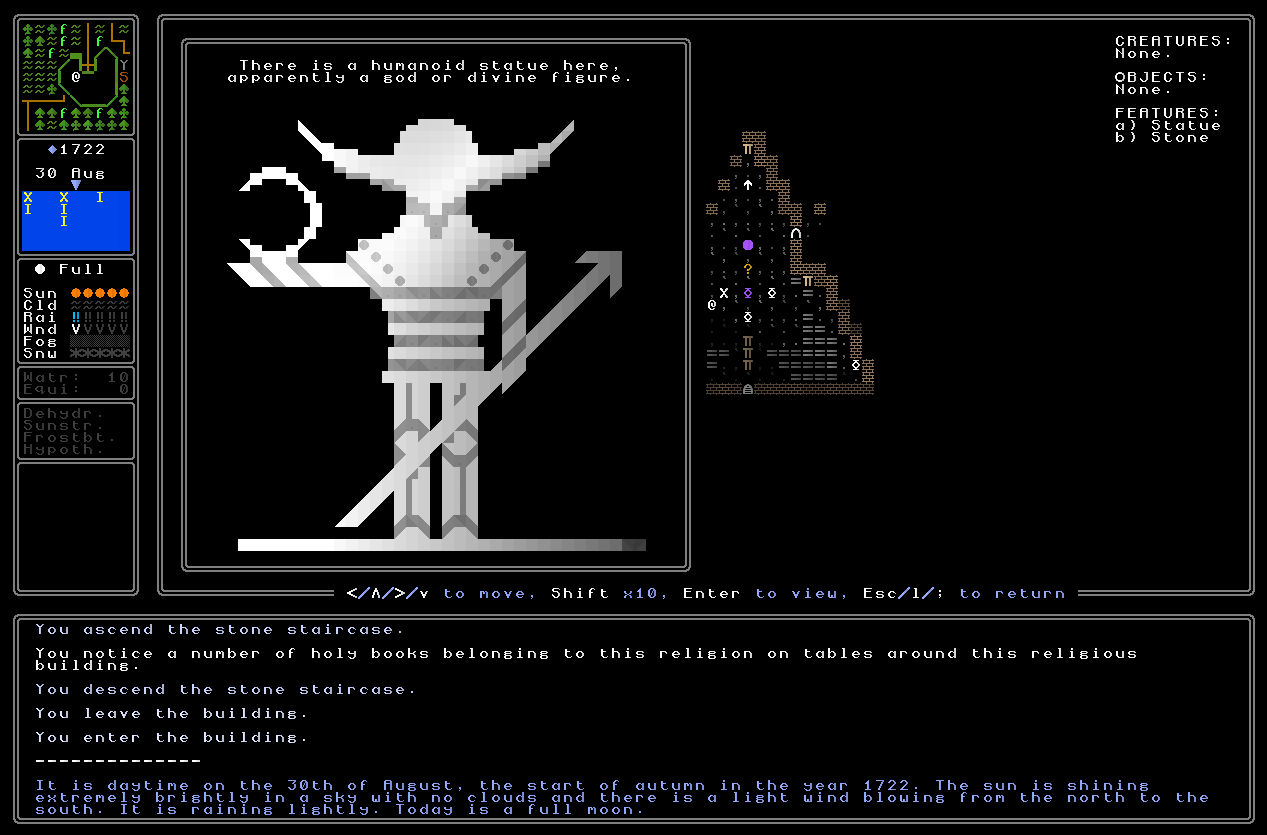
I think it’s pretty clear which one this is!
Letters
Next we come to letters and numbers, which is again one of the archetypes I showed off previously, but as well as being combined with the graphics of all the other clue archetypes, it has also been reworked and improved in a number of ways. The game can now generate a grid of arbitrary size – up to the limit either horizontally or vertically of what will fit in the window – and populate it with letters or numbers in any appropriate order or sequence or pattern. I also recognised that some of the letters and numbers inevitably looked quite similar (S and 5, 2 and Z, 1 and I, etc), so the numbers now have a black border around them whereas the letters are just the black text by themselves. These are slightly trickier puzzle type, and the idea here is that the player is looking to recognise particular chains of characters which might appear elsewhere, so if there is a civilization called for instance the Snake Kingdom of Sasama, and somewhere on a note you spot the characters SKOS, then those may well be a match. As with many of the other clue archetypes I’m showing off in this post, this is all about getting the player to observe connections, to learn the world, and not just to make all the stuff I’ve been putting in so much detail for the last thirteen years incidental background or world building, but actually essential to completing the game, And of course, in turn, to make the world sufficiently rich in detail that it is in fact interesting and compelling to learn about and become familiar with all these cultures and religions and histories one needs to know about in order to decipher what these clues and riddles might be pointing towards. Here, then, are some examples from the redone generator for this archetype:
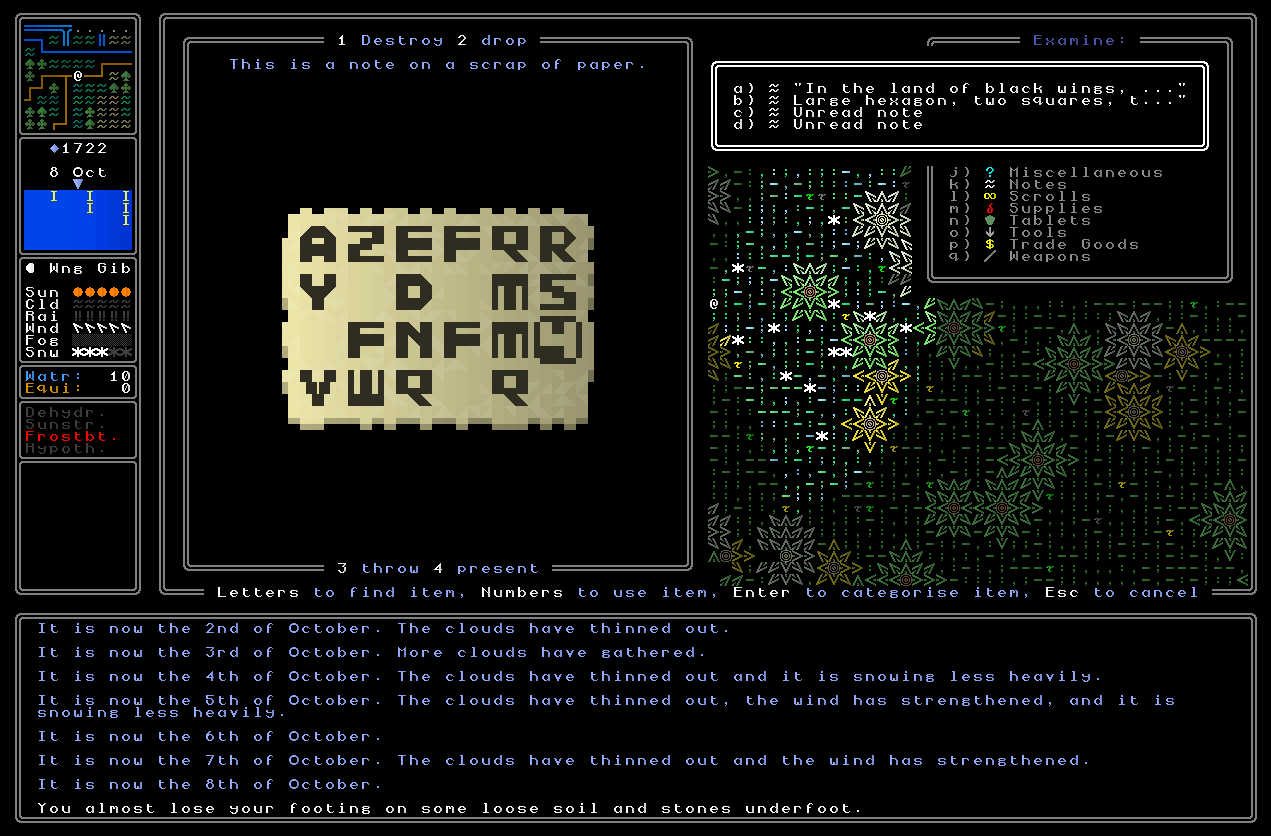
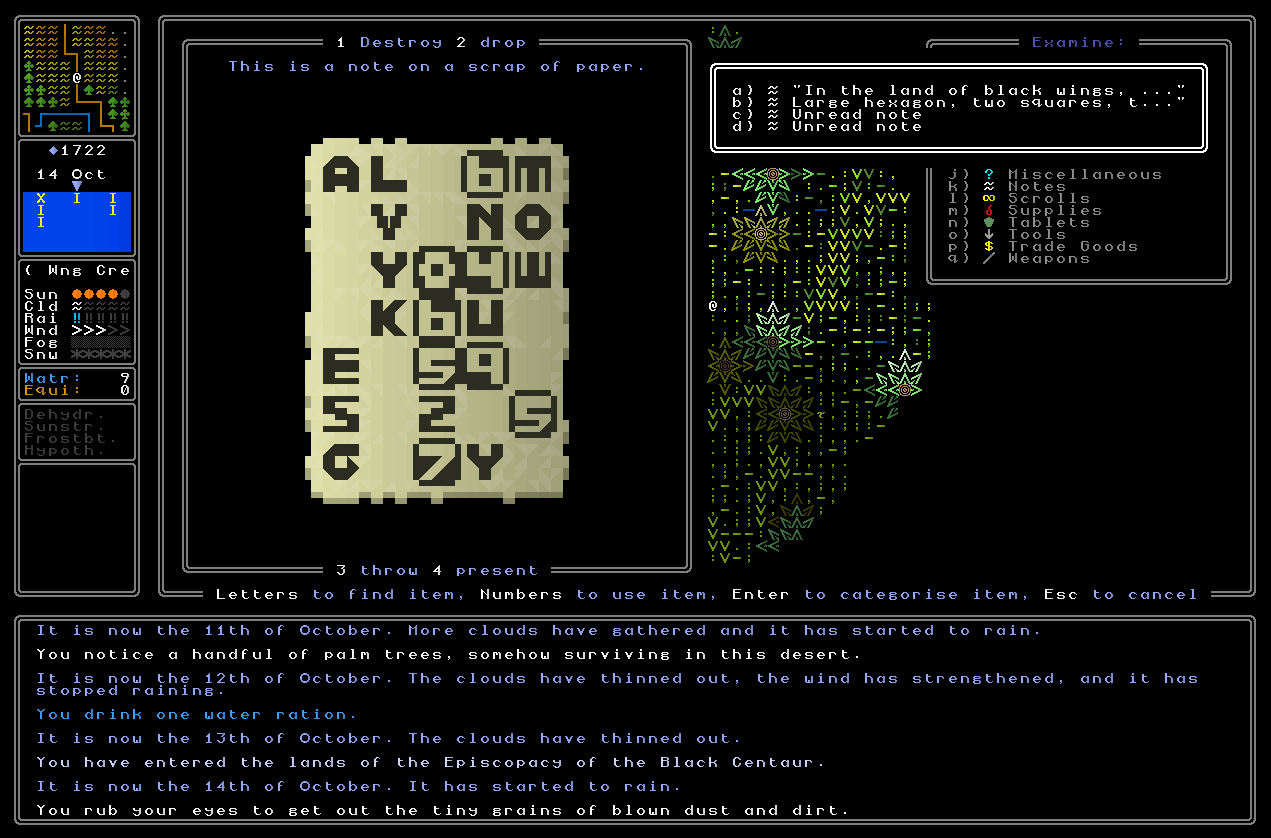
Weird Symbols
This then brings us to a really neat new archetype which I came up with in the last few months, and which I really like. In the image from the earlier post you’ll see the one with a number of square or cross-like symbols with a line dividing two sets of those symbols. I liked the idea of populating the world with abstract symbols whose meanings one has to discover on each playthrough, and which could mean quite literally anything – they might be a place, a plant, an event, a person, a religion, a nation, a god, or anything else. At some later point I’ll talk about some sort of in-game dictionary function that will be required for these, but at first I was making abstract symbols without any intention of making a new archetype from them, and simply putting together a set of interesting 7-by-7 symbols that could serve in this regard, rather than the symbols I showed up in the early example at the top of this page. Once I had these, however, I started to really like how these looked, and I came up with the idea of a clue archetype that connects together a number of these abstract symbols, and the connections or lack of connections on the page would demonstrate some of the meaning to be divined. For this to happen the game therefore not just tracks what symbols should be printed and where they should be printed, but also which ones should be connected. The symbols are carefully built to make sure that every symbol will always have at least one way to to connect vertically and horizontally, in both directions, with every other symbol in the database, but some have multiple ways to do this in order to boost the visual diversity of what the player sees. Here are some examples:
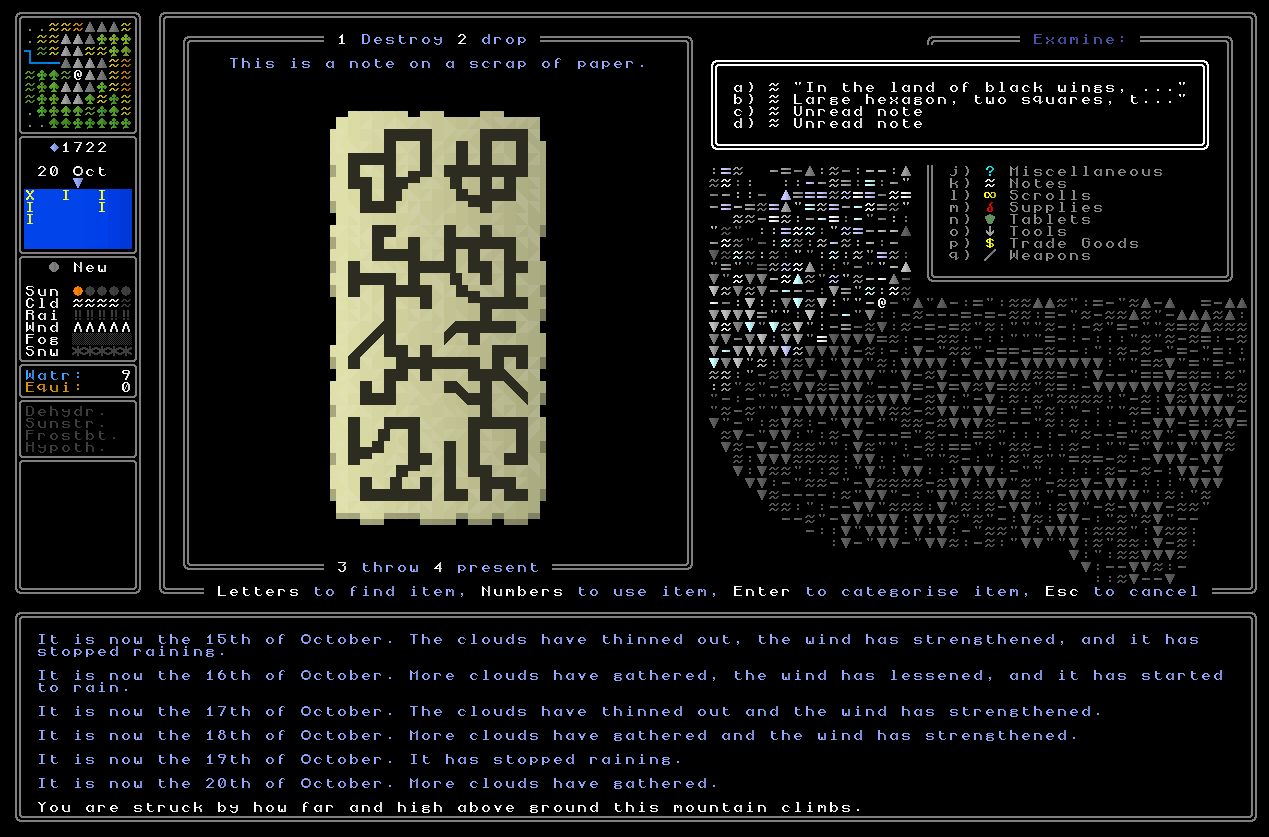
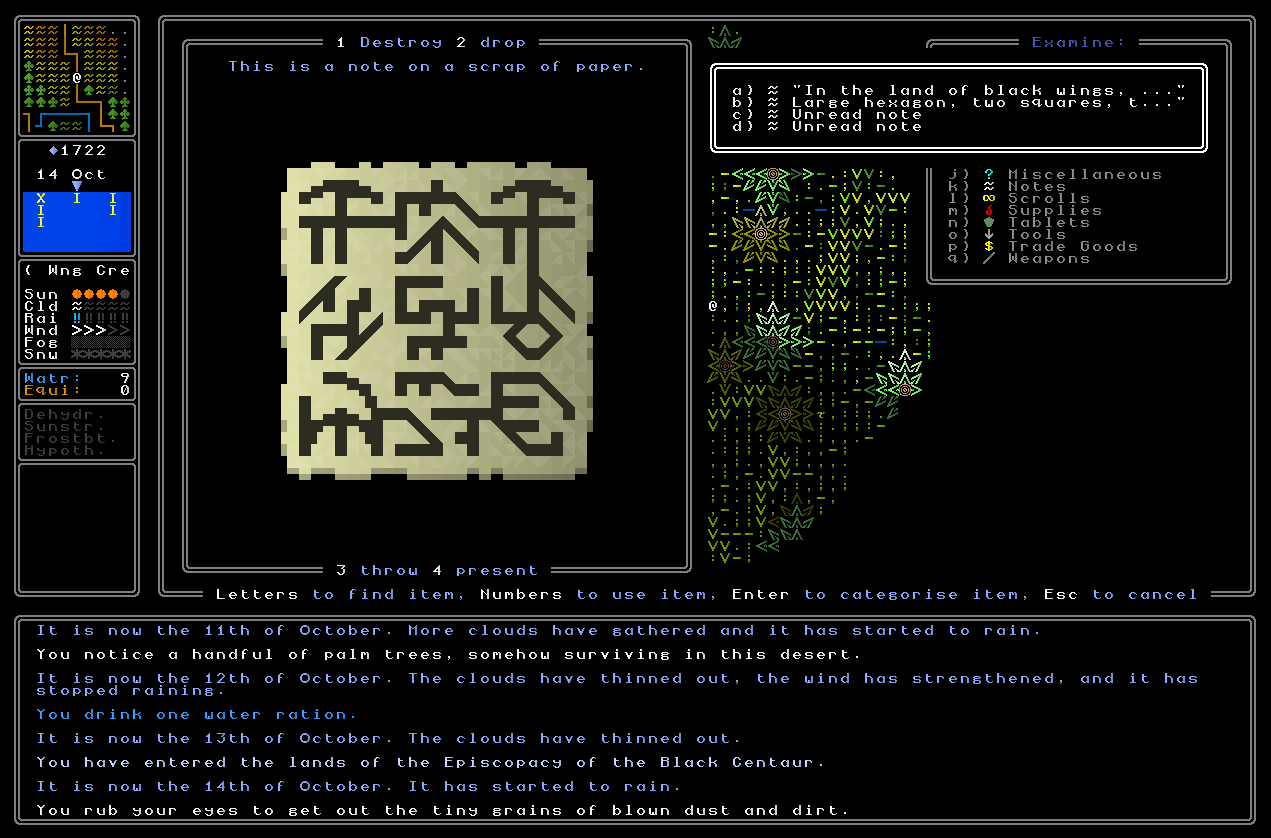
As I say, the goal of this clue type will be to make clear connections between things the player might not otherwise know there are connections between. For example, if one were to learn what in this set of abstract symbols represents a particular military order, and maybe you found another symbol that refers to a particular place on the world map, and you find a clue where these two symbols are joined, then perhaps it would be a good idea to show someone from that military order a map of that area, or book about their area, or simply ask a relevant military person about the area in question, and that would then trigger some next step or yield some more data which would enable the player to progress. In a sense then this is one of the most abstract clue types, yet one which I expect will wind up giving some quite fundamental hints and instruction to the player on what sort of connections might exist between things which can then be further interrogated, and by using abstract symbols rather than symbolic representation in these clues, varied connections between anything can be drawn and articulated here. Again, I think this offers exciting possibilities, and I’m really pleased with how these look as well.
Shapes
This next archetype I’m calling the shapes archetype, and I really love how this one looks. While lots of the archetypes basically involve two colours, one for symbols or text or information and the other being the background colour of the note, this is one like the maps where I’m able to deploy a large number of other colours as well. So this archetype essentially features a range of shapes, which can be empty, filled in, or contain colours, and here are two examples of what I mean:
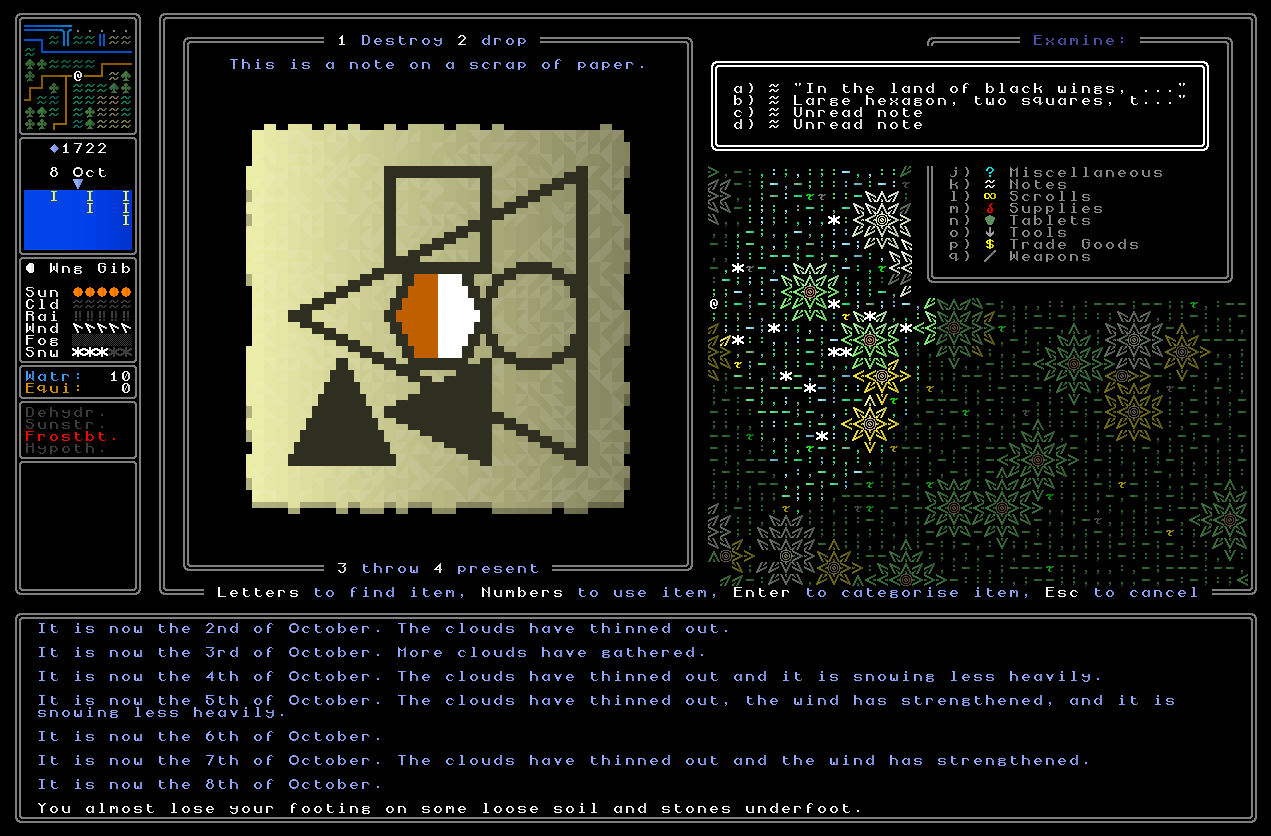
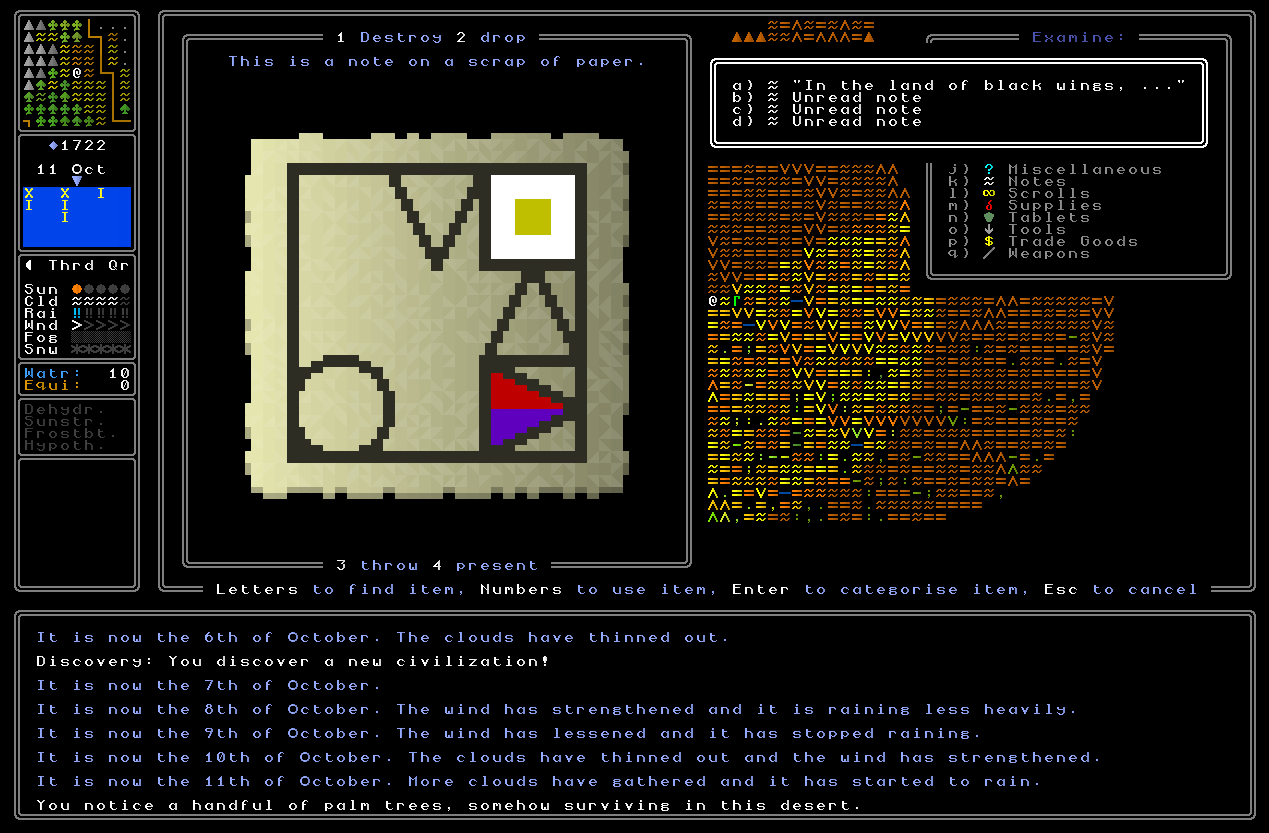
Colours of course might relate to nations or religions or to other combinations of colours which the player has learned have some other secret or hidden meaning – maybe for ingredients for some bizarre hallucinogenic potions, for example – or might mean a range of other things as well. The player will therefore find in books and text and in conversation with people information describing how certain things are like a triangle, or like a circle, and providing appropriate philosophical or metaphorical justification for why those things are like these shapes, and then these clues would be again telling you connections between things, potentially tells you spatial relations between things. I think for this archetype we might even have cases that appear in large numbers with subtle differences and part of how these are used are finding those which truly reflect the information which you’re trying to acquire. Overall I really dig how these look, and I like how cryptic and impenetrable they seem at first glance, yet with the potential to tell the player important things.
Formula
Next we come to what I’m calling the formula archetype. This is another one which was shown off in a very basic way in the earliest set of clues shown above, but has been massively expanded and enhanced. This can now pick an orientation in any of the four cardinal directions, as well as any suitable number of component parts – two, three, or four – as well as giving each of those a range of different sorts of information, such as a symbol that gives some data, and number of volume, a time of day, things of this sort. Then the single symbol by itself will represent the thing which is being added up to. Most obviously I imagine these clues being useful for learning what sorts of things can be combined into potent drugs or cures or the like, but I can also see strong metaphorical use here in this idea of combining things together. One might have a clue arguing that several historical events led to another historical event, or perhaps that several lands came together to form another land, or that the three most important parts of a nation are X, Y and Z – or whatever it might be. This clue archetype therefore offers a lot of flexibility for depicting the idea that several somethings combine into making another something, as well as giving varying levels of information about that something. Again, feeling happy with how these are looking now – much more varied than they were before – and drawing from the very large databases of both representational symbols, and abstract symbols, as well as things like numbers and times of day and quantities and so on.
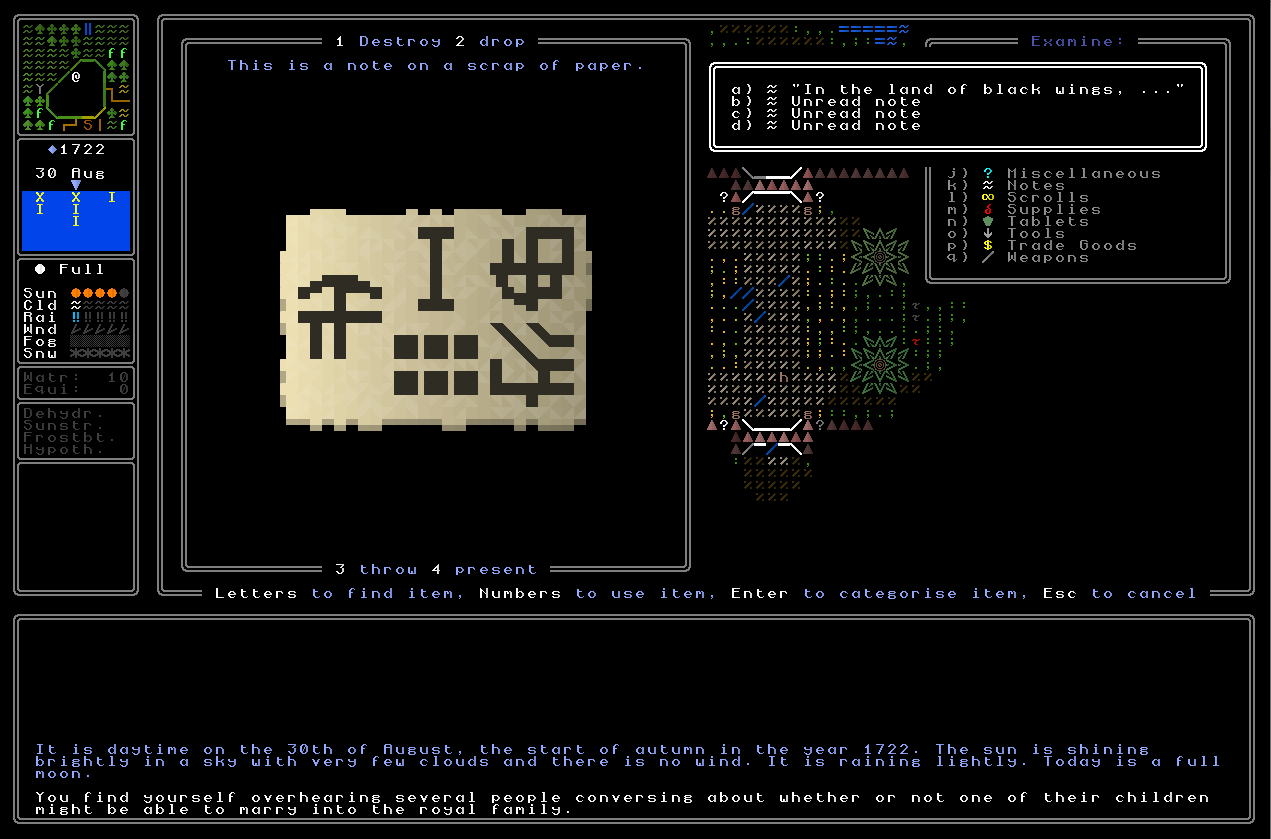
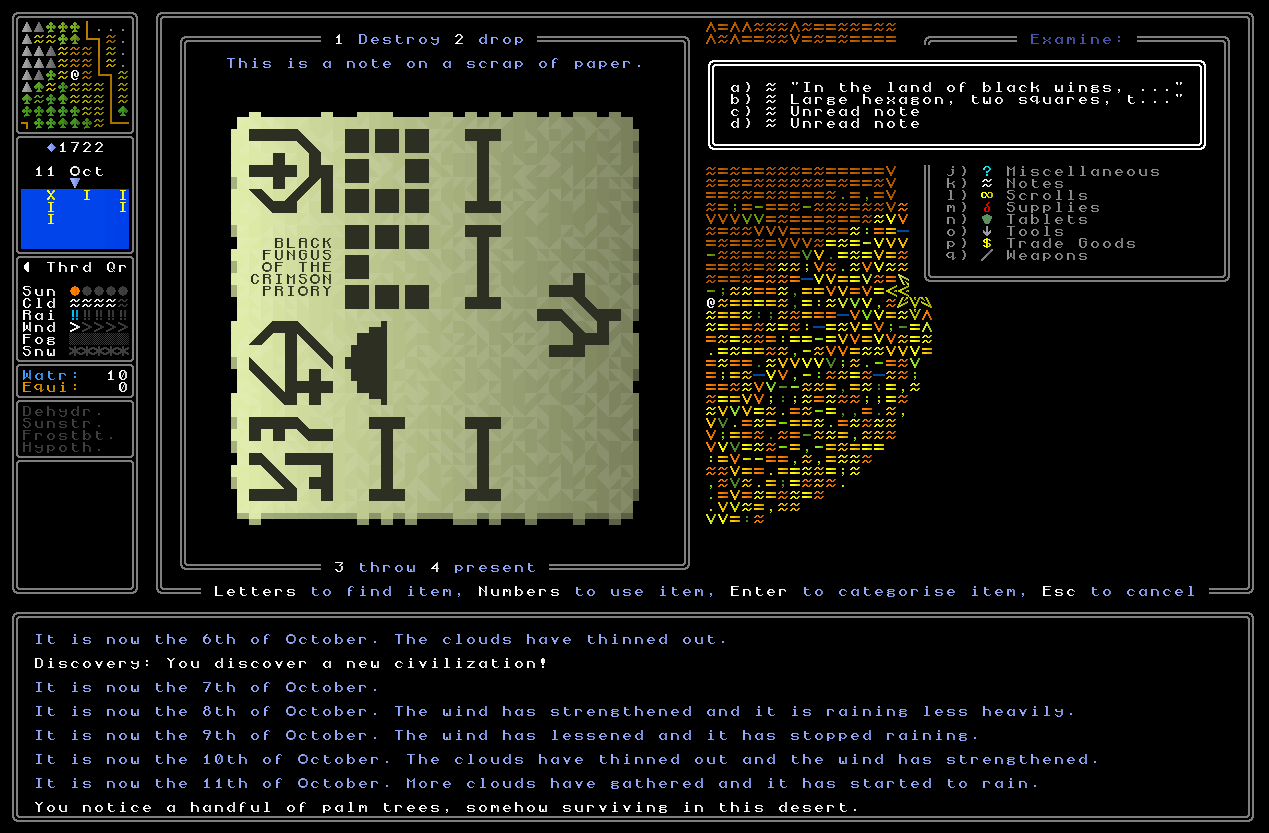
Grid
This brings us to the grid archetype, in which arranges symbols – they can be weird symbols, they can be letters, they could be representational symbols, or any combination – to show up in a grid, either surrounded by various colours, or showing colours themselves. I think at this point in the entry you’ve all got a good sense of some of the sort of things I’m trying to get across here, and some of the diversity uses and interpretations and meanings that each type might each have, so I don’t actually think I need to really elaborate too much more about this one. I think it’s again very visually pleasing, and I’m really happy with how these have come out.
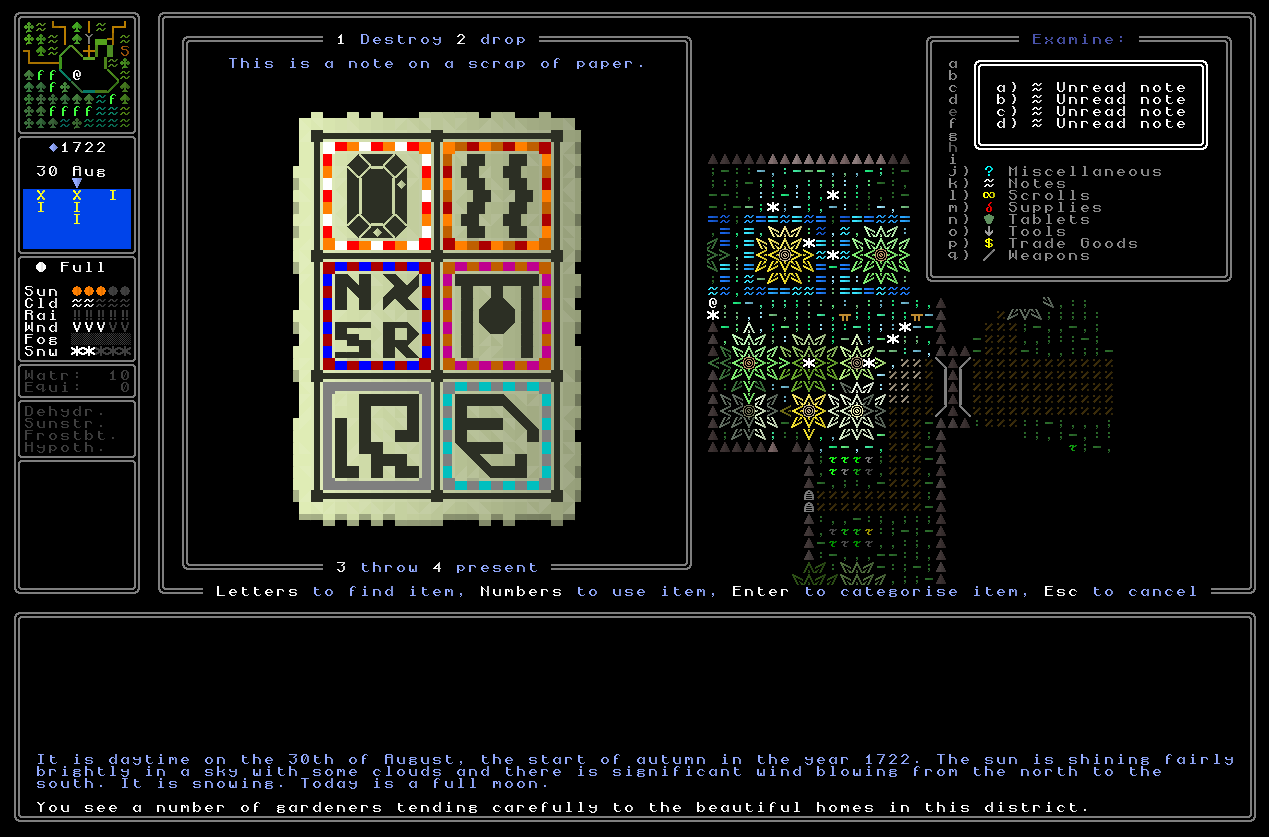
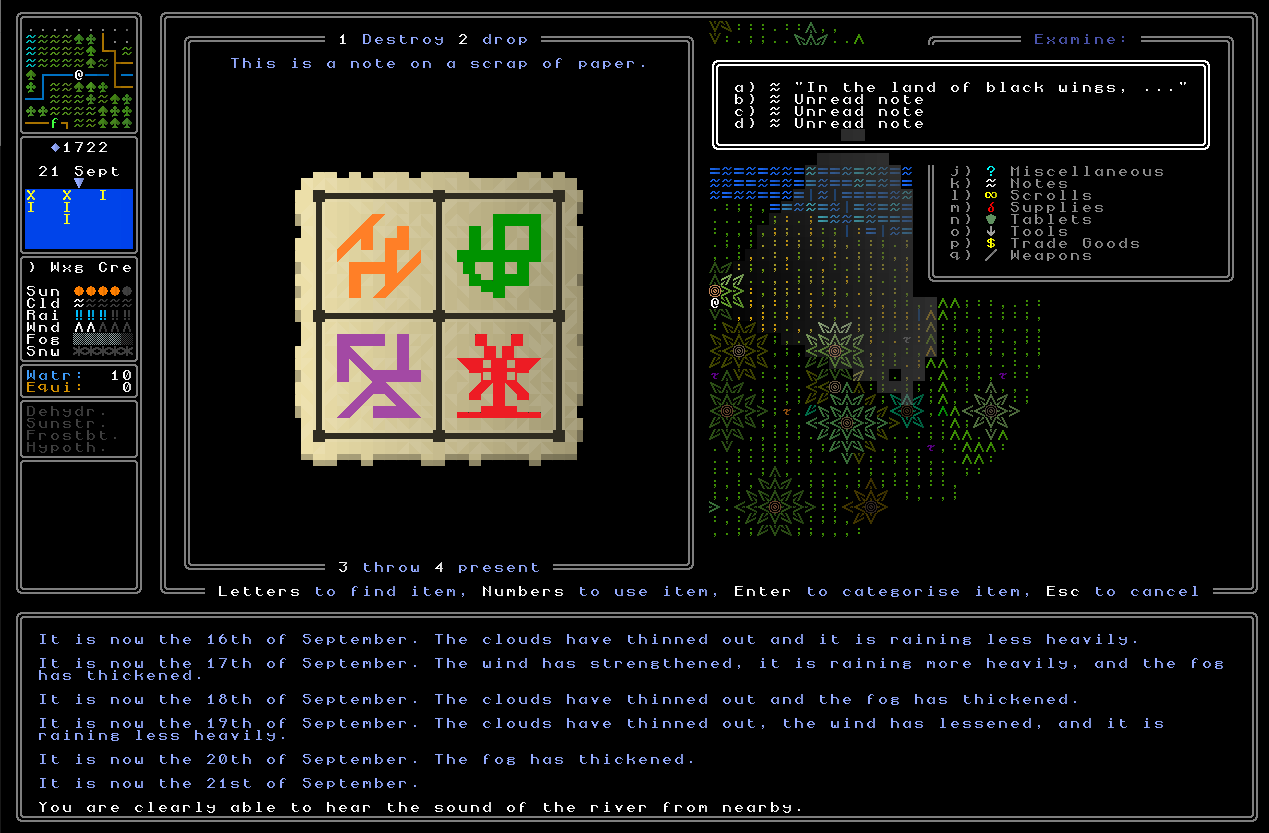
With that said though, in case it’s all seeming a bit abstract, I’ll give some examples of what we might draw from these two notes. On the first one, for example, we have a particular gemstone, followed by some kelp, then four letters, then a gong, then two symbols which might anything in that particular generated world. Then we look at the borders, some of which have multiple colours and some of which have just one colour, and so one could easily see how this could be – for example – telling a story of how a gemstone was passed from person to person or place to place, and when used in combination with a written source the visual source here would fill in the blanks in the written source, and the written source fills in the banks in the visual source, allowing the player to hunt down where this extremely valuable gemstone might be hidden. In the second example, where the colours are deployed differently, perhaps orange & purple, and green & red, are the two colours of two opposing nations, and since one shows a particular kind of religious statue, perhaps one might conclude that the purple is showing the abstract symbol for the religious statue from the other nation’s religion, and that these symbols in orange and green are those representing the nations in question. Again, there’s such an extraordinary range of things that the generators will be able to do here that I really think I will be able to achieve my goal where with the player not being able to use previous games to infer or deduce what meanings might be encoded in the clues and riddles in the later game. I’ve got to say, I think this is all very exciting.
Spatial Pattern
Our next clue archetype is the spatial pattern, which again showed up in a basic form in the examples at the top of the page, and hasn’t in fact been changed a great deal. The idea here is to show some spatial or geographical relationship between a single thing which we’re looking for, and a number of other things of a certain type. The key point or central thing would be the star, and the others would be the squares around it. As with all the clue types here, the idea is that this can be used to show the player a massive range of different kinds of information. Maybe in one case the star represents an altar, and the squares represent places where you need to place offerings around that altar. Maybe in another place that are four towns in a pattern as shown by the squares, and so you need to head to the map tile which the star would represent. Maybe in other cases it would be representing buildings on a local map grid, where you need to enter the building shown by the squares using the star as your starting reference point (or vice versa). There also many many many other examples of what these could represent again, and one of the great things about this particular clue archetype is that the same pattern could be used in multiple different solutions – so all those I just listed above in this paragraph could all be true for a given pattern, when combined with other clues. This ability to reuse clues in multiple ways, or get more data out of the same clue, is a really compelling idea and something I want to explore further as we go along here. As with many of the others, therefore, these clues are designed to be used with others, rather than standing on their own, as some others do. For now though, I think it’s clear how these work, and here are some in-game examples:
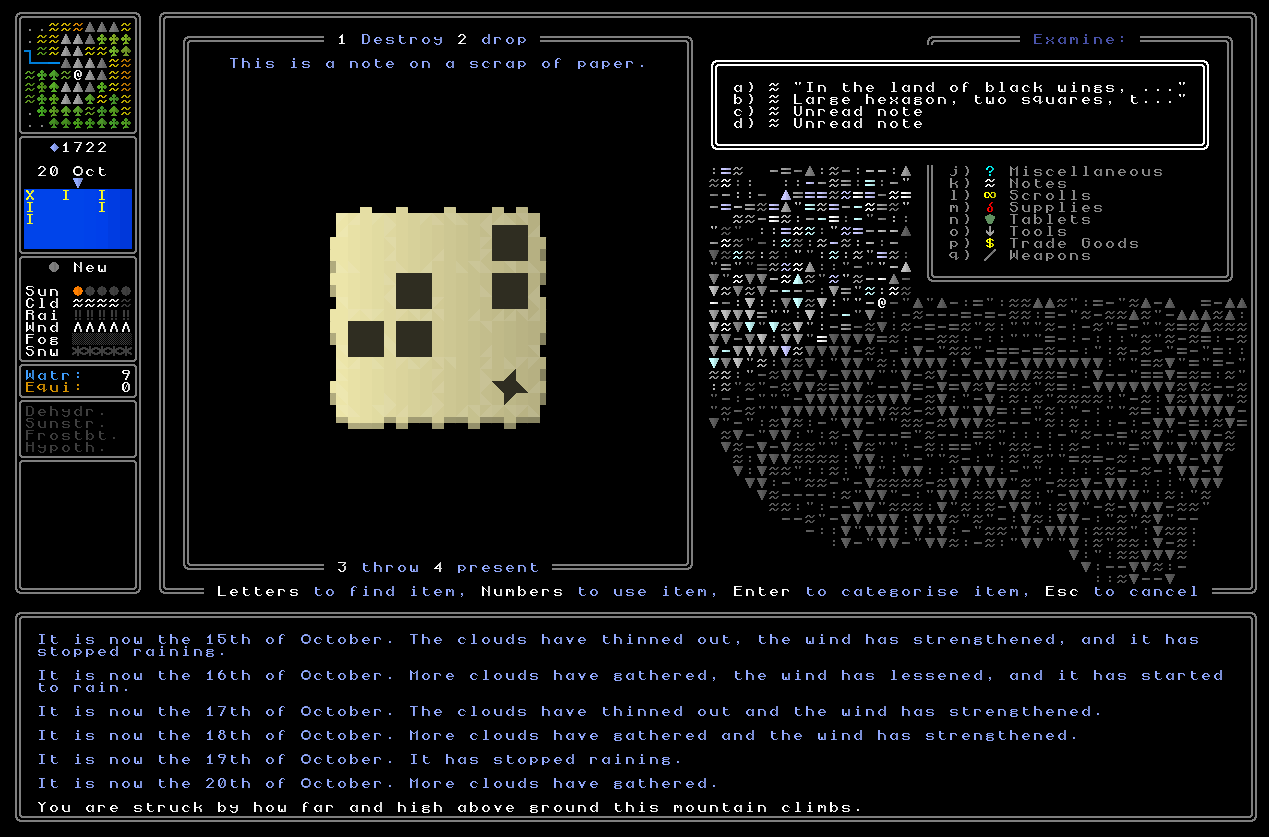
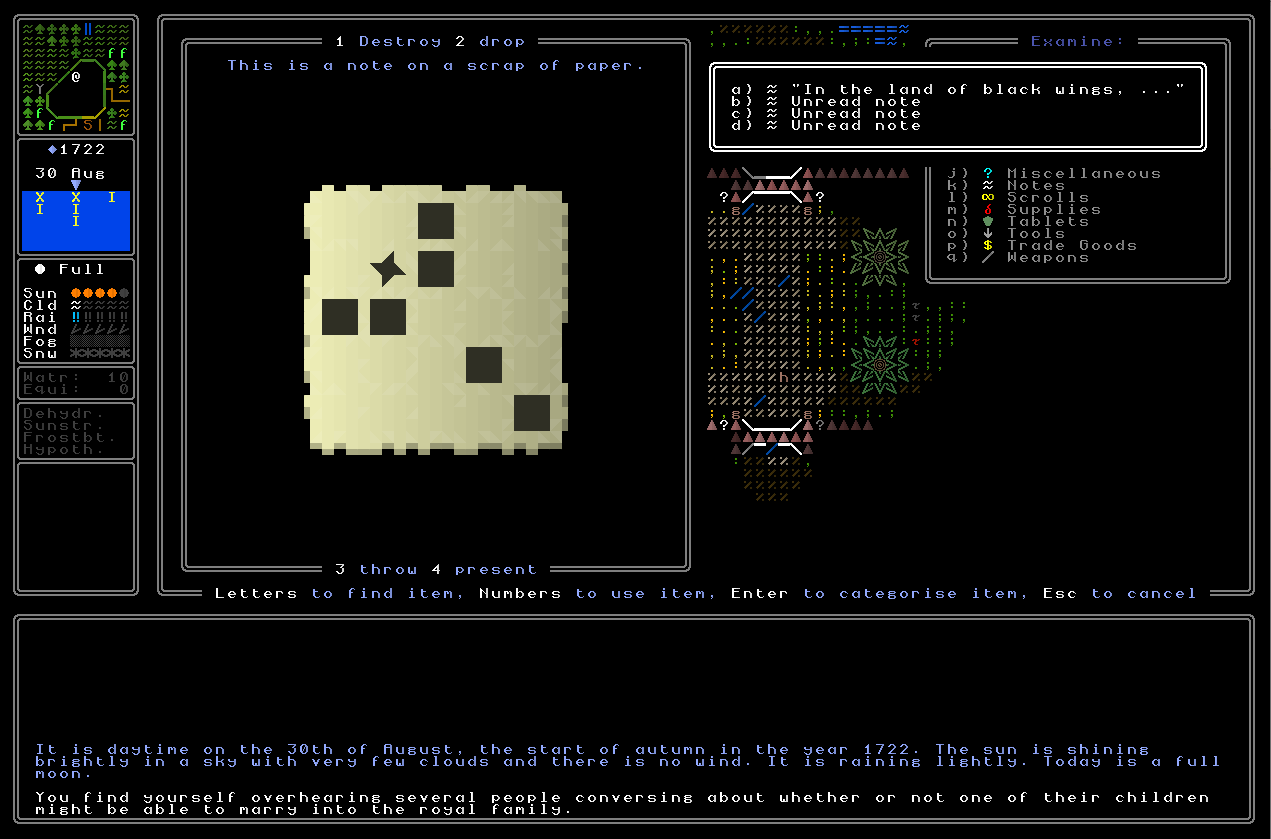
Focused Information
Last but by no means least, this brings us to this archetype, for which I don’t have a great name but I’ll call it something like the “focused information” archetype. This has a single symbol in the middle – again it could be a cryptic symbol or representational symbol, and I suppose could even be a piece of a map, potentially, as the system has been so completely rebuilt from the ground up that all these images and types and sorts of visual data can be freely manipulated by the system when they’re now being placed into logical configurations – and then around it, in various directions, other sources of information such as letters, numbers, symbols, and colours. Not every single one has to have all the directions flushed out, and here are some examples:
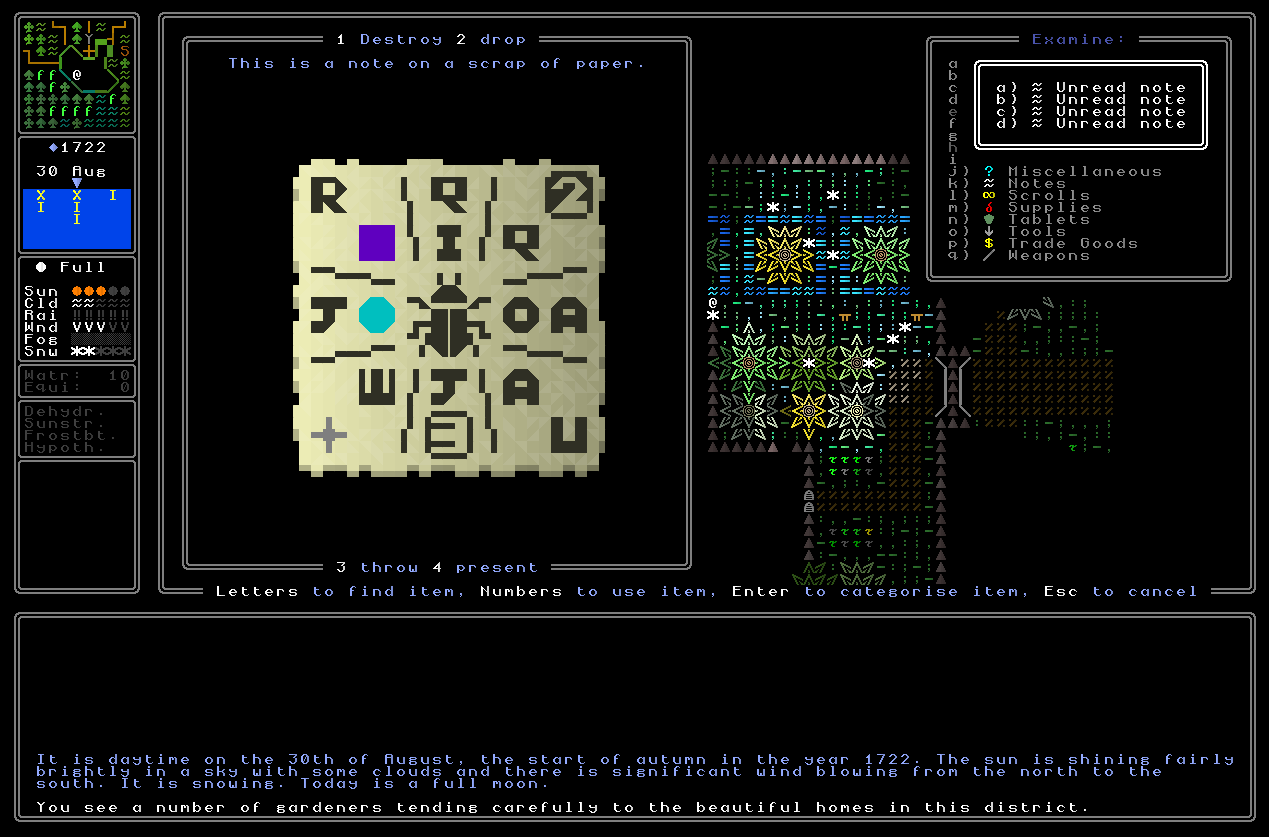
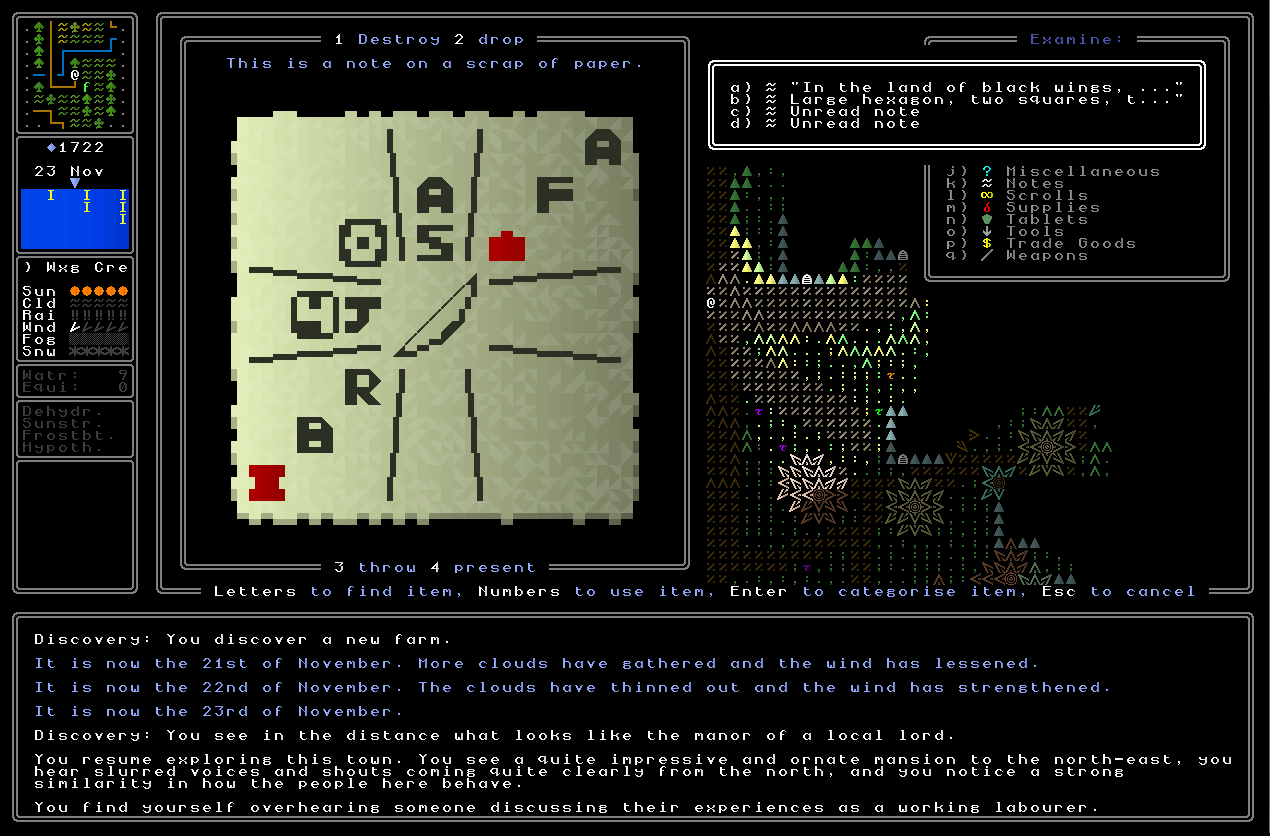
So in the first example here we are learning information about a species beetle – or perhaps about a religion that worships beetles, or a civilization with beetle in its name, or an area of the world map which contains beetle in that name, or a historical event involving beetles, or a settlement with a name involving beetles… and you get the idea. Again, the player would need to decipher which is correct based on other data, their knowledge of the world, and so on. Then the information around it would be designed to give more data about that thing. Sometimes the directions would be relevant and sometimes they would not be, so for instance perhaps “QI” and “OA” are the initials of towns to the north and to the east of what the clues trying to direct you towards, but also at other times they could be giving you other kinds of information as well. The same is true in the second example, where we see the bow and fewer directions with flushed out information here. These might relate to particular civilizations which use those shapes and colours as their as their aesthetic preferences, but again could be referring to almost anything as long as it can be compressed down to no more than three letters, numbers or symbols in order to convey the information to the player. On the spectrum of clues that will stand by themselves and clues to be used in tandem with others, I think these will likely end up somewhere in the middle, and should be able to offer quite a range of variation between those two extremes.
Final Thoughts
Whew! I hope all of this has been as exciting and slightly crazy to read as it has been to develop. What I’m increasingly seeing is that there’s a very good reason why no one else is really doing procedural generation of cryptic riddles – it has taken me thirteen years (!) to get to the stage where these can actually be implemented, and where we can then create a quest generation system which involves following these sorts of threads, combining information, and so on. I have to say though, I’m incredibly proud of how these have come out. Aren’t they just lovely?
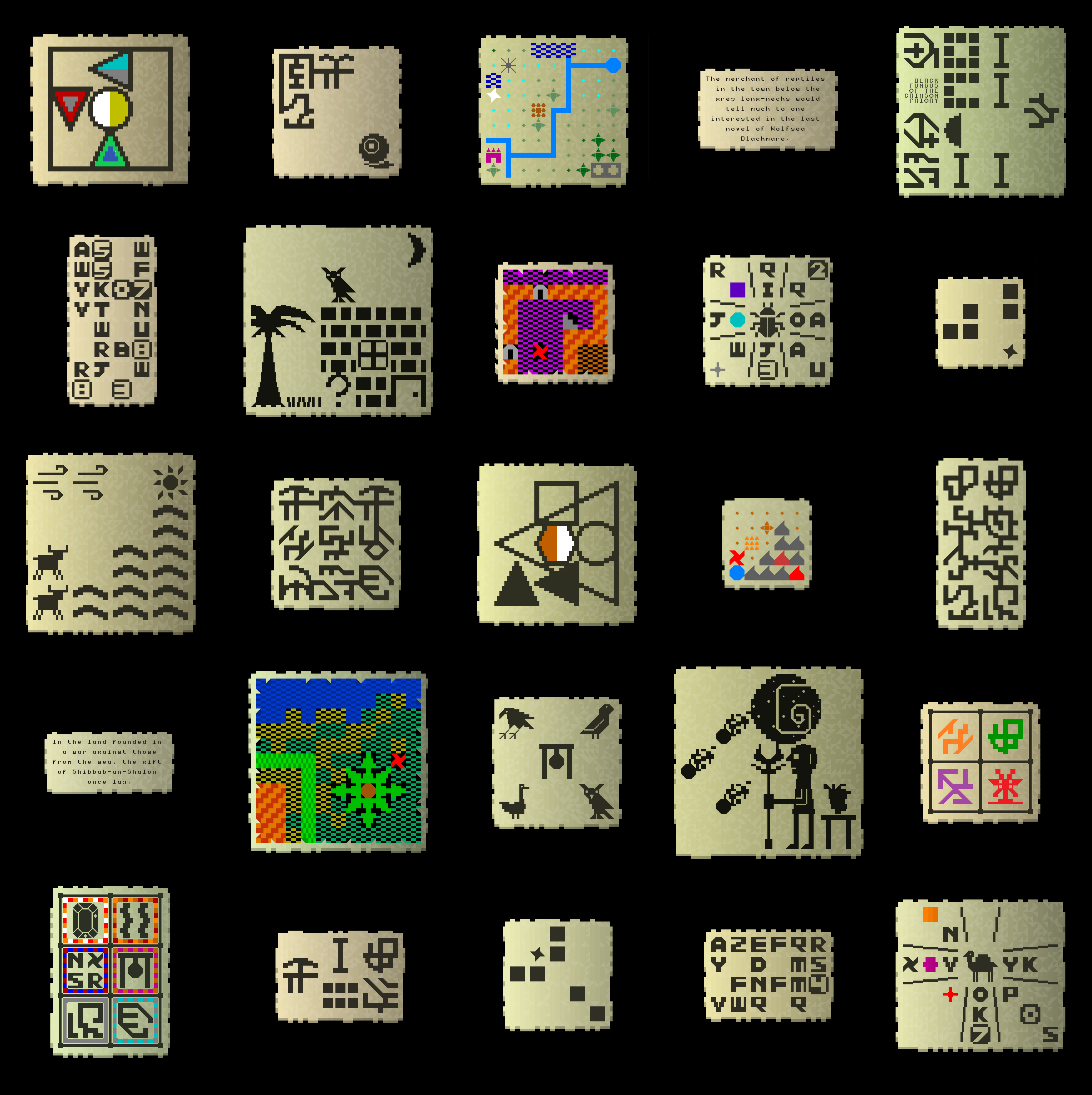
The next stage, then, is to finish every single one of the generators behind these archetypes. As above, the examples shown are generated from basic generators, i.e. enough to draw something that’ll show off the archetype for this blog post, but unfinished. Now the serious work is making the full generators, and the generator to connect the clues made by the clue generator (although, in practice, that’ll work the other way around of course – make the thread first, then make (a) clue(s) for each step). When coupled with the two other objectives – finishing off all the unfinished features I’ve been working on in the last year and have mostly finished, and a required massive bug hunt – that’s everything that remains for 0.11 (and only the first two for 0.10.3, which I’d like to do as an interim release). For the rest of this year I’m going to be aiming to get 0.10.3 out in 2024, or if not, then extremely soon afterwards. It’s an ambitious target, but everything that still needs doing is very much in the “polishing” and bug-fixing line of things, so I think it’s a good focus to really give myself for these remaining two months of the year. And, even if I don’t quite make it, it’ll still be huge progress, so a win either way. Riddle and quest generation will then continue in the background until I next have another update to post about all this.
Oh, and I almost forgot. On top of all these models I’ve shown off here, I’m also experimenting (so I stress that these are very work-in-progress) with other variations too! So this is far from a complete list. This might include colour variations such as clues / notes that are very clearly colour-coded as being relevant to religions or nations…
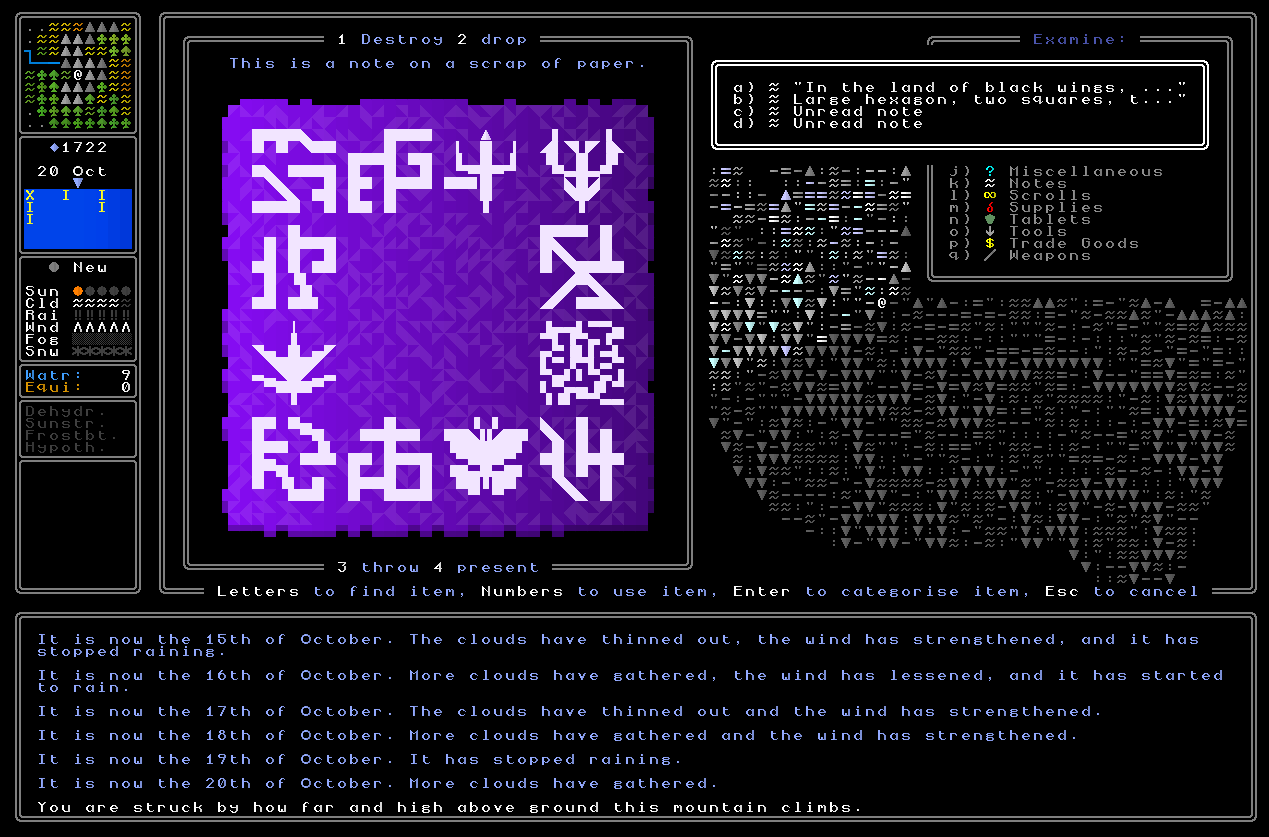
…and might also involve other things that obscure or complicate the clue, such as splashes of ink on the page, or even damaged parchments!
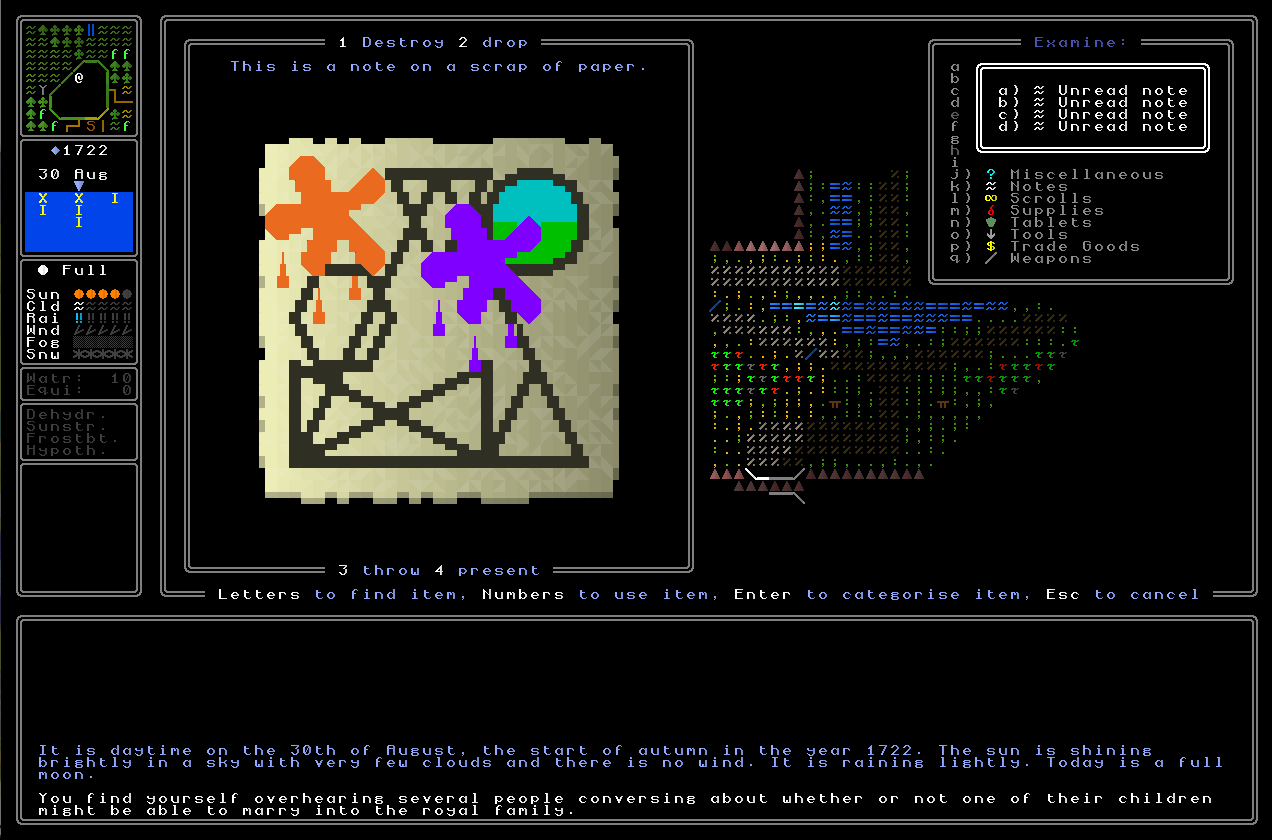
But those are still very much in development :). Ditto a number of other archetypes I’ve had ideas for and I’m sketching out, but none of those are really looking how I’d like them to yet, so we’ll have to see whether they make it in, or get left behind on the drawing board.
So, there we have it, friends. I honestly think this procedural riddle generation work is really rather cool stuff, it’s exciting to be really pushing PCG into a novel direction. I’m not saying this to be self-aggrandizing, but because this is exciting, and I’m excited by it – and I really hope you are too. As ever, please do leave a comment with your thoughts, or share this in a community you think might be interested in it, and I’d absolutely love to hear your thoughts. You can always follow URR on Facebook or Reddit, or get updates via Twitter. And truly last, but not least: if you have cool ideas of other clue archetypes then please do let me know in the comments!
Thanks everyone – I’ll see you all in three weeks for the next update :).
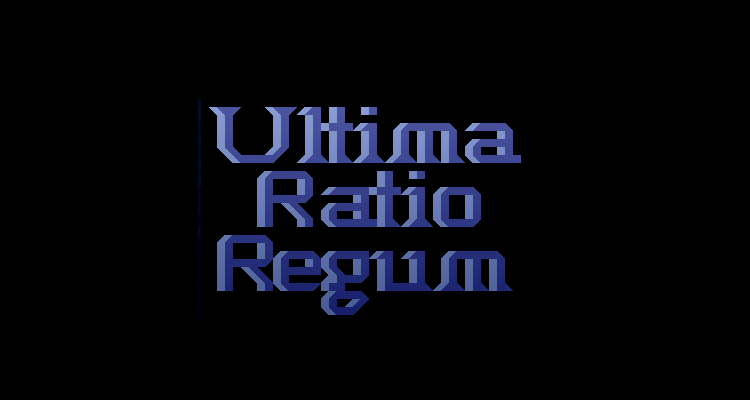
“Mind-boggling work as always”, as always!
The sheer range of cryptic stuff here is incredible, and has been well worth the effort.
I’m wondering a few things (sorry for length, please don’t feel obligated):
You mentioned it’s important for people to take notice, and I think that’s great but I’m also wondering how you might mitigate a potentially slow/frustrating early game onboarding. For example in one of the visual clue examples, it might well be that usage of squares is meaningful – but how does the new player even find out that “geometry has the potential be a thing” in this game, without either observation/time, multiple quick deaths and restarts, some kind of manual/wiki/word-of-mouth, etc? If the game is more exploratory rather than deadly (like Qud) do you plan on there being some kind of “breadcrumbs” for newbies?
Related – could the sheer possibility space and fairly long playthrough time (which I believe was discussed in a much earlier post) combine to mean that any given player would hardly scratch the surface and potentially not notice/appreciate what was going on procedurally? Wondering if the plan was for a more “collective knowledge” approach like DF, where people trade knowledge through stories as part of learning the game? Soulslike restricted-vocab note dropping even?!
I think overall what I’m getting at is, this game has the potential (and deserves) to be a REALLY long term talking point, and like all the classics the complexity and depth maybe justifies a somewhat confusing first few tens of hours. So how does a new player approach the game – do they need to do their homework alongside experimentation or are you thinking of more of a guided crib sheet approach (“pay attention to the physical form of statues; colour and shape might be important”)? Or are you going to include SO many puzzles that patterns/differences can be spotted more easily?
Some smaller questions:
With the pictorial clues it’s really easy to imagine why these might be cryptic – lack of artist’s skill/knowledge/memory, ancient scripture, secret codes, artistic interpretation etc. With the textual clues it’s maybe a bit harder to see the in-game reason for these, unless the overall story includes a “riddler type” character dropping clues for you, or these are messages intended to be lightly obfuscated to confuse the uneducated. Could this be attributed to the vagueness of language and translation, as part of the language features you mentioned maybe being in the game?
Lastly, with general visual stuff are there any plans for alternative text description for accessibility? Thinking colours, partially sighted etc. Could give spoilers for some of the embedded nuance of the images but would be worth it, and certainly an interesting design challenge. Might just be a case of allowing an option/mod/plugin for those that want it.
Asked constructively and with love. Thanks for the fantastic update!
Neil, thank you so much for such a great comment (so many good questions), and the kind words! They are both hugely appreciated.
1) Great question. Definitely going to have a sort of tooltip thing – and maybe you start with a short book giving notes on someone ELSE’S research into the world’s secrets and riddles? I think that could be quite a nice idea. It could even generate a puzzle, and generate that person’s written explanation of that one in their journal, then finish with something like “I found all these other materials, too… what could they all mean?!”.
2) Ooh, interesting. The fact someone made a Wikipedia page for the game – which I need to get around to updating – was a huge moment a few years ago, and I would expect a little later down the line that a dedicated Wiki might come into being. I’d love to see people sharing interesting solutions to tricky riddles, too! That would be wonderful. But yeah, I don’t think I’d want a single playthrough to hit everything, far from it. I definitely want to get a community sharing ideas for tougher puzzles, and quest threads that should be able to ramp up in difficulty to become very cryptic, have a *large* number of pieces that have to be connected, and so on. I imagine these being inputs into the quest thread generator, i.e. how many steps do you want, but also, how complex should each step be – and one should be able to push that up to an arbitrary limit.
3) I definitely think just giving the new player a few tips, then letting them go off and explore, is the right way around. I really relate to what you’re saying, that actually a confusing start can become something extremely rewarding. I know I felt that way back when I was playing NetHack for the first time, back in “the day”. At the same time, the fact that nobody has done the procedural riddle thing before does, I think, necessitate *some* degree of guidance, but… not too much. The difference between saying “keep an eye out for anything” and “keep an eye out for x, y and z”, I guess?
4) Now this is a great question, and I have no good answer yet! I’m still working on the overarching story, the player’s impetus to explore, etc. So I’ll come back to you on those in the near future :).
5) YES! 100% – I’ll have an option to turn off colour-based puzzles, and then those just won’t be added to the game’s database (or I’d have variations, so for instance red-green colour-blind option would only remove situations where those exact colours need to be distinguished). But yeah, definitely, and I think the modular nature of the quest thread generation should allow for this without a truly excruciating amount of work on my part…
And thanks again for such a detailed comment, Neil! I really do appreciate it 🙂
Thanks for the reply Mark. With the riddles I agree some guidance like “ANYTHING can be a clue” might be enough, especially combined with stories online describing the kinds of quest specifics that other players have come across.
The “unfinished previous explorer journal” idea is neat too. Potentially could be combined with a procedural tweak that allows clues for the first puzzle or two to generate more locally, even if still fairly obscure in nature. That way (maybe while the player still lacks resources to travel too far) it’ll narrow down the possibility space to something more manageable for newbies.
Thanks again for the updates.
Thanks Neil! Yeah, the more I think about it, the more I like the idea of giving the player a “solved” riddle that someone else previous solved, so give a sense of how it all goes. And, yes, absolutely – I definitely plan for the ones the player’s given at the start to be limited to the starting civ (maybe even the starting university!) for exactly that reason (and obviously they’ll have few steps & few pieces, too…)
I’m blown away by the sheer variety of clue archetypes and possibilities on display here. I very much echo Neil’s comment about it being “mind-boggling”! I can definitely see players asking for help on forums, etc with clues and more experienced players helping them out with possible interpretations. Since each generated game world is unique, there’s only so much that other players will be able to assist with, but I think that’s a good thing. I can imagine a surge of excitement that a player will feel when they connect a clue to something in their game world (e.g., this symbol represents this particular culture! or, these initials are of THIS town on the map!). Maybe players will post in-game maps or dumps of their in-game journal so other players can look them over. Will there be a way to export the map and journal to files?
Re: onboarding, I really like the idea of having the player either start with or quickly acquire a journal/notes/book from a previous explorer who was working on the same puzzle that the player will be pursuing. This would be a great way to introduce the basics of the game, and would make sense given that the player works in a museum. Perhaps finding out what happened to the lost explorer ends up being part of the game (e.g., Indiana Jones in The Last Crusade uses his father’s grail diary to track down the holy grail, and in the process finds his missing father held captive in a castle). The journal could perhaps contain (generated) possible interpretations of some clues, most of which would be incorrect but would be clearly marked as speculative. This could then form the basis of the player’s own, continuing journal as they explore the world.
Regardless, the clue system in URR is shaping up to be very exciting. It’s fascinating to me as a reader to see the development of what amounts to an entirely new *genre* of game.
Thanks so much crowbar! “There’s only so much that other players will be able to assist with, but I think that’s a good thing” – yes! I love the idea that players won’t be able to GUARANTEE a solution for another player, but CAN point them in the right direction, give some suggestions, etc. I think that’s a really cool dynamic, and a very novel one, as well. Having an export function is also a great idea – I’ll definitely include that.
Yeah, the more I think on it, the more I like the “previous explorer” idea! I like it a lot, actually – and, heh, the idea of the lost explorer actually appearing later is kind of neat as well. Again, I’m coming back to some of these fundamental questions about the player character’s motivation, the fundamental *why*, which does need solving… although not quite yet. Love the idea of listing a bunch of speculative answers – love that. In general, actually, someone *else’s* thoughts on a riddle should be another clue type! “I found a cryptic note that talked about X… I remember I once heard from a trader in Y that X had something to do with Z. Maybe there’s something to it?”, etc.
And, thanks :D! It is really exciting, honestly. 0.11 will be at some point next year, and I’m so excited. I’m even debating hosting some kind of little competition – with a prize! – for the first player to complete the one “proof of concept” quest thread 0.11 will have, but we’ll get to that when we get to it…
I’m repeating what the other commenters already said. Wow, extremely impressive and innovative work!
Massive variety of stuff. The pictures are really cool, I’d think they give a lot of different ways to give knowledge to the player, and flesh out the world and make it feel lived in.
It’s really nice to see the game take shape through these devlogs, because this really is amazing progress and something never really done before. Also, your RL Celebration talk and demo was really interesting, can’t wait to see the grander and more intricate “quests” you’re able to generate and how the different pieces will slot together. Exciting stuff!
Thanks for spearheading this work and giving me a lot of inspiration for what I’m currently working (and struggling) on.
Keep it up!
Cheers
Thanks so much Nick! It’s a real pleasure doing the devlogs, honestly – it *is* extra work, but getting feedback and making such a long-term commitment *seen* (instead of just being something I’m doing secretly or in the background) makes it more than worth it. I’m so glad you liked the talk, too! I’ll definitely be doing a “Part 2” to that one in a year or so, for sure. And, it’s really cool you’re working on a project too, always happy to chat or give feedback if I can be of any use!
It would be awesome to have a chat and get some feedback, but first I want to have more to show! Otherwise it’d be lovely to have a small talk about this sort of procedural narrative game design in general. It’s an understandably underdeveloped topic and I’d love to get your opinion on some of the stuff I’m thinking about and trying to develop! Expect me in your inbox the coming months though haha
Absolutely! Sounds like a plan to me, Nick. If you send me an email and I don’t reply for some time, it probably got junk mailed, so just give me a shout here :).
Amazing work as always!
The variety and possibilities for all of these puzzles is almost overwhelming. It’s going to hugely satisfying when you really dig deep in to the world and can read the symbology of various maps and hints and can apply them directly to your knowledge of the game. I suppose one comparison would be understanding masonic architecture and symbolism within the real world and being able to detect it when out travelling.
Looking forward to seeing more!
All the best!
Kyle
Thank you Kyle! Yes, absolutely, that is exactly what I hope for (and what I think is coming together now) – and that’s a great real-world comparison, too. I’m so glad you like how it’s coming together! I’m so excited to build the quest generator for these in 2025…